Sail away to Western France
Scroll for your ultimate guide to slowing down and exploring lesser-known France by car…

Every good road trip needs great music, so before you continue, be sure to hit play on our Western France-inspired playlist!
Western France: The highlights
Thousands of years of history, authentic Gallic culture and cuisine, and kilometres of diverse landscapes to traverse

Normandy
Mont-Saint-Michel
There’s no denying how striking Mont-Saint-Michel is, set on its own island surrounded by the dramatic tides of the bay. You’ll be following in the footsteps of centuries of pilgrims when you explore its warren of streets that climb up to the abbey church, built over a period of some 1,300 years.
The D-Day Landing Beaches
Pay a respectful visit to the beaches on which the British, American and Canadian troops landed in June 1944. The museums, cemeteries and memorials here tell of the true heroism of D-Day, as well as the daring and meticulous plans that preceded it.
Giverny
See the waterlily-strewn ponds and Japanese bridge that inspired Claude Monet’s paintings at Giverny, where his garden still colourfully bursts into life each summer. Monet’s house, meanwhile, showcases the daily life of the Impressionist master, who was passionate about Japanese art and loved hosting friends in his brightly painted home.
Bayeux
This medieval Normandy town is best known as the home to the millennium-old tapestry that tells the story of William the Conqueror’s rise to the English throne. Also leave time to visit Bayeux’s Gothic Cathedral dating back to the 12th century, the grand 17th and 18th century townhouses, and the fine restaurants and cafés.
Rouen
Set on the banks of the Seine, the city of Rouen lures history-lovers. Its links to Joan of Arc are told through the multi-media experience Historial Jeanne d’Arc, while Monet was so taken by the cathedral’s façade, he painted over 30 views of it. Seek out the Gros-Horloge astronomic clock and admire the medieval architecture.
Brittany
Saint-Malo
Saint-Malo’s old town is surrounded by ramparts: walk around the top of the walls before diving into the narrow, cobbled streets below for gourmet food stores, crêperies and cafés. Elsewhere, stroll along the sea front, and explore the many museums dedicated to the town’s seafaring heritage.
The Carnac Stones
Brittany’s answer to Stonehenge comprises nearly 3,000 aligned stones covering an area of over four kilometres, thought to have been erected some 6,000 years ago during the Neolithic-era. Join a guided tour and visit the on-site Maison des Mégalithes to deepen your understanding.
Pointe du Raz & the Cap Sizun
The Cap Sizun leads out to the Pointe du Raz, France’s westernmost point. Enjoy coastal walks across its heather and gorse-strewn headland, with the Atlantic crashing against the cliffs below. Explore the working fishing village of Audierne and take a trip out to the bijou Île du Sein.
Canal de Nantes à Brest
Relax on a boat trip along the Nantes to Brest canal, an over-360km waterway that cuts through inland Brittany and passes through a landscape dotted with castles, characterful towns and the Réserve Naturelle de Gomel. Alternatively, follow the smooth cycle paths, or even take to the water in a canoe.
Pink Granite Coast
The sea and wind has hewn the pink granite boulders along the coast near Perros-Guirec into something of a natural sculpture park. Walk along the coastal path to admire them, stopping for picnics or paddles on the beaches. Better still, take a paddle board out to see them from the water.
Atlantic Loire Valley
Le Croisic’s Coastline
On a peninsula that curls around the bay, the picturesque fishing port of Le Croisic is a good base. Across the water, Guérande is home to a centuries-old tradition of salt cultivation, and nearby La Baule offers a nine kilometre beach with elegant sea-facing Belle Epoque villas.
Pointe du Payré
With sweeping white sands beneath turquoise waters, Vendée’s estuary at Pointe du Payré and the Plage du Veillon are reminiscent of Australia’s Whitsundays. At this protected natural site, enjoy walks across the sand dunes and the craggy cliffs. Stop at the oyster-farming village of La Guittière to swig back the seafood.
Sainte-Suzanne
Sainte-Suzanne in the Mayenne department is regularly counted as one of France’s ‘Most beautiful villages’, and its hollyhocks and neat stone cottages makes it easy to see why.
The village is surrounded by medieval ramparts and its chateau (which famously saw off William the Conqueror) is set on a promontory overlooking the Erve Valley.
Le Mans’ Historic Quarter
While Le Mans is best known for its car racing (cf. 24h du Mans), the city’s Historic Quarter (also called the ‘Plantagenet City’ as it is the birthplace of the Plantagenet dynasty) is worth a lingering sojourn. Its cobbled streets and half-timbered houses were used in the celebrated 1990 film adaptation of Cyrano de Bergerac, as well as many other movies.
Poitevin Marshlands
The Marais Poitevin is the second largest area of wetlands in France and its area of wet marshland is known as ‘Green Venice’. Hire a barge from one of the many jetties and punt along the waterways admiring wildlife including otters, herons and tree frogs.
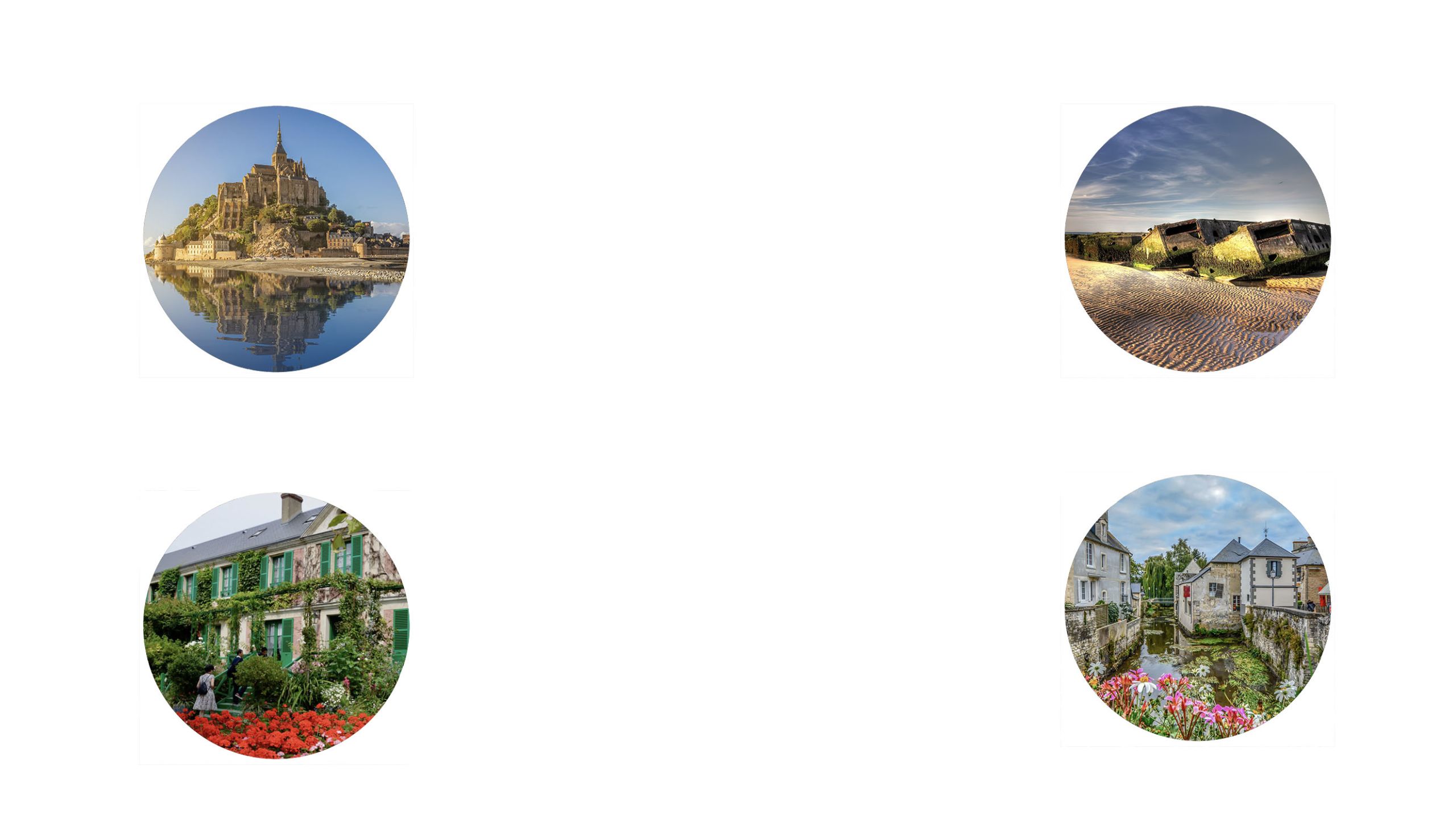
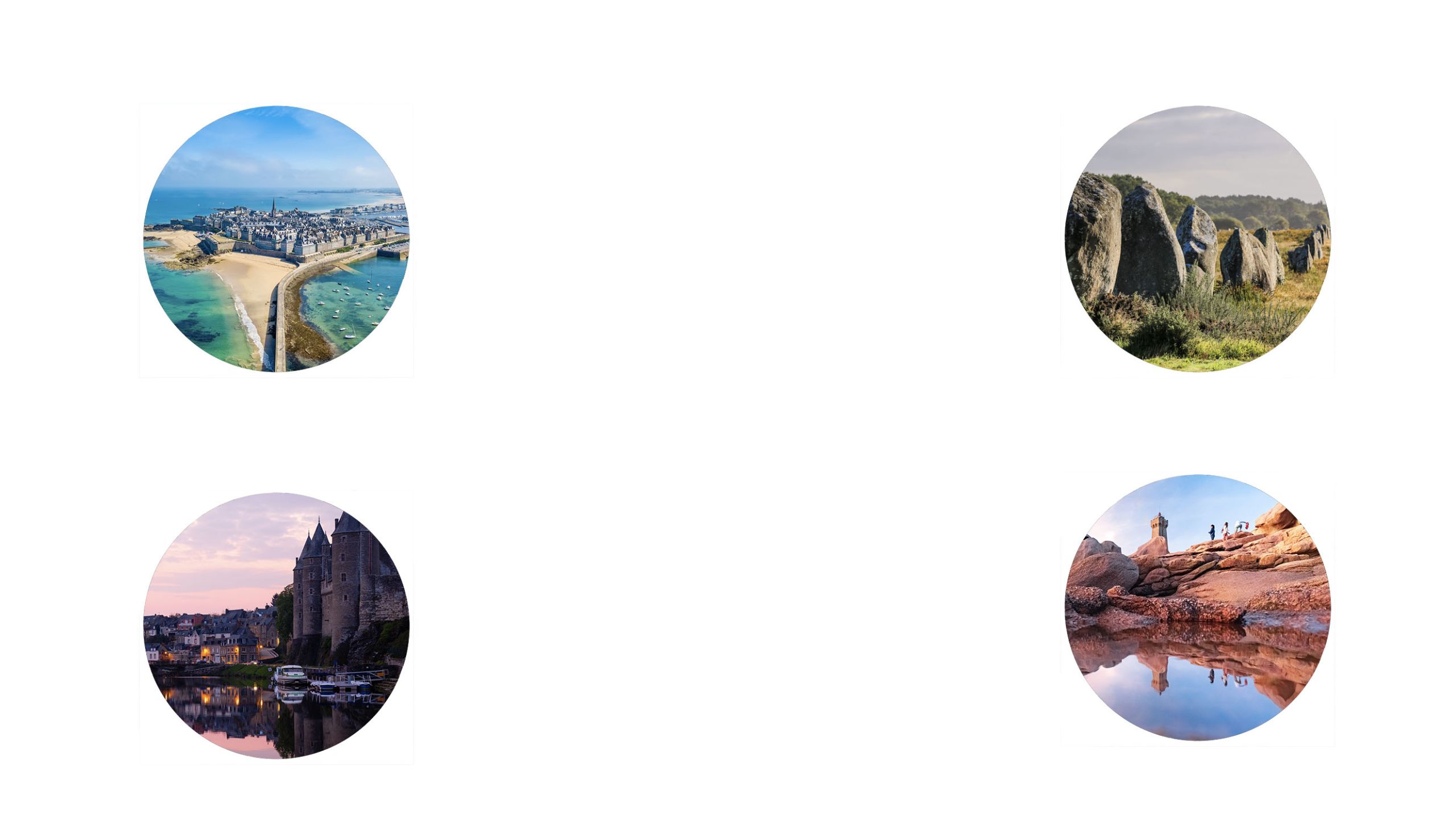
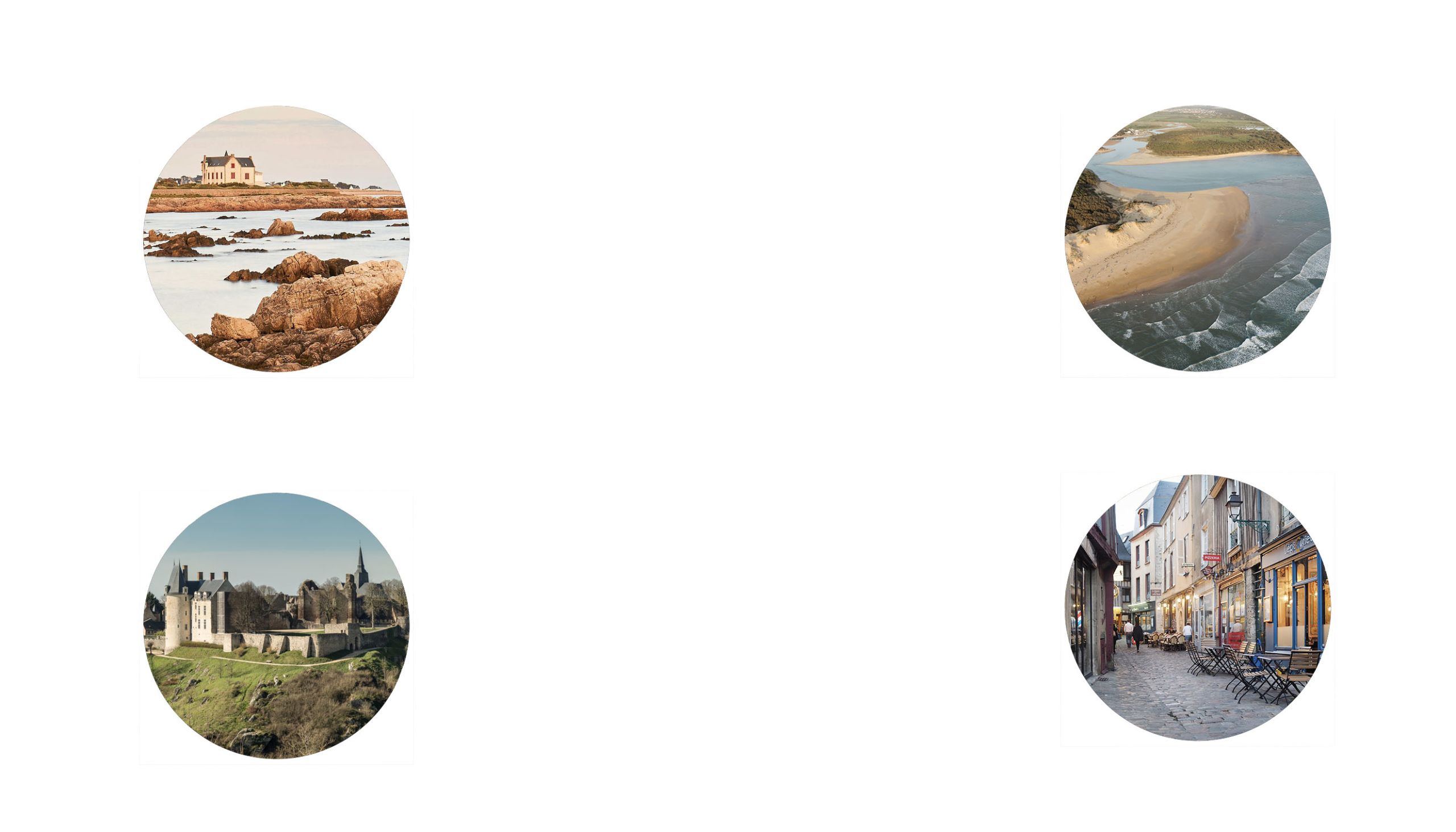
Road trip one: Drive through nature
Follow this road trip for dramatic coastlines, craggy paths and bird-rich waterways…

1. Le Havre to Le Tréport
Distance: 143km (by car) or 194km (walking)
Sail into Le Havre with Brittany Ferries: less than four hours from Portsmouth, it is one of its faster routes. From there, the GR21 – voted France’s best walking trail in 2019 – follows the path along the Alabaster Coast taking in sights such as the limestone cliffs at Étretat, which inspired Impressionist artists including Monet. You can also crunch along pebble beaches, saunter through verdant meadows and pause for refreshments in harbour towns such as Saint-Valery-en-Caux. From there, it’s on to Le Tréport, a bustling fishing town with chalk cliffs that are among the highest in Europe at 106m above sea level. Next, head south to Rouen.
2. Rouen to Le Havre
Distance: 138km (by bike)
Normandy has over 500km of cycling routes covering its coast, countryside and waterways. Among the many multi-day routes is La Seine à Velo, a new 420km trail from Paris to – depending on which route you take – Deauville or Le Havre in Normandy. Start at Rouen to follow the River Seine through the Boucles de la Seine Normande Regional Natural Park. You’ll pass orchards, meadows and the ruined Abbey at Jumièges, where the route forks. Choose the road to Deauville and you’ll pass the Marais Vernier wetlands (look out for migrating birds, frogs and Highland cows) and Honfleur with its famous harbour en route. Alternatively, pedal past the Roman ruins of Lillebonne to finish in UNESCO-listed Le Havre.
3. Le Havre to Souleuvre
Distance: 144km (by car)
Heading westwards, your destination is an area named Suisse Normande (Norman Switzerland) thanks to its rugged, wooded landscape, featuring jagged gorges cut from the landscape by the Orne river and its tributaries. Here, spanning the valley above the river, the Souleuvre viaduct (built by Gustave Eiffel) is a partially dismantled railway bridge that is now home to adventure sports centre, Skypark Normandie by AJ Hackett. Gaze down into the forested valley and the River Souleuvre before leaping into the void with either a bungee jump, pendulum swing or the 400m zip wire that goes at a speed of 100km/ph.
4. Souleuvre to Cap de la Hague
Distance: 143km (by car)
It’s back to the coast now, with a loop into the Cotentin Peninsula, which juts into the Channel. Drive through the peaceful countryside and farmers’ fields to its north-west tip, where the Baie d’Ecalgrain is a great spot for coasteering. Protected by a helmet, life jacket and wetsuit, you can clamber into inlets with the sea crashing below and jump into the dense blue water from the rocks. The unspoiled beach is the place to relax afterwards, backed by empty hilltops, where wildflowers abound.
5. La Cap de la Hague to Granville
Distance: 128km (by car)
Head south towards the seaside town of Granville where the coast road skirts past empty beaches, including Gouville-sur-Mer where colourful beach huts are tucked into the dunes. From Granville’s harbour, a ferry can take you to Les Îles Chausey. Head out in a sea-kayak to see the wildlife that lives among the 365 islets (52 at high tide); spot sea birds, seals and dolphins as you paddle on the crystalline waters.
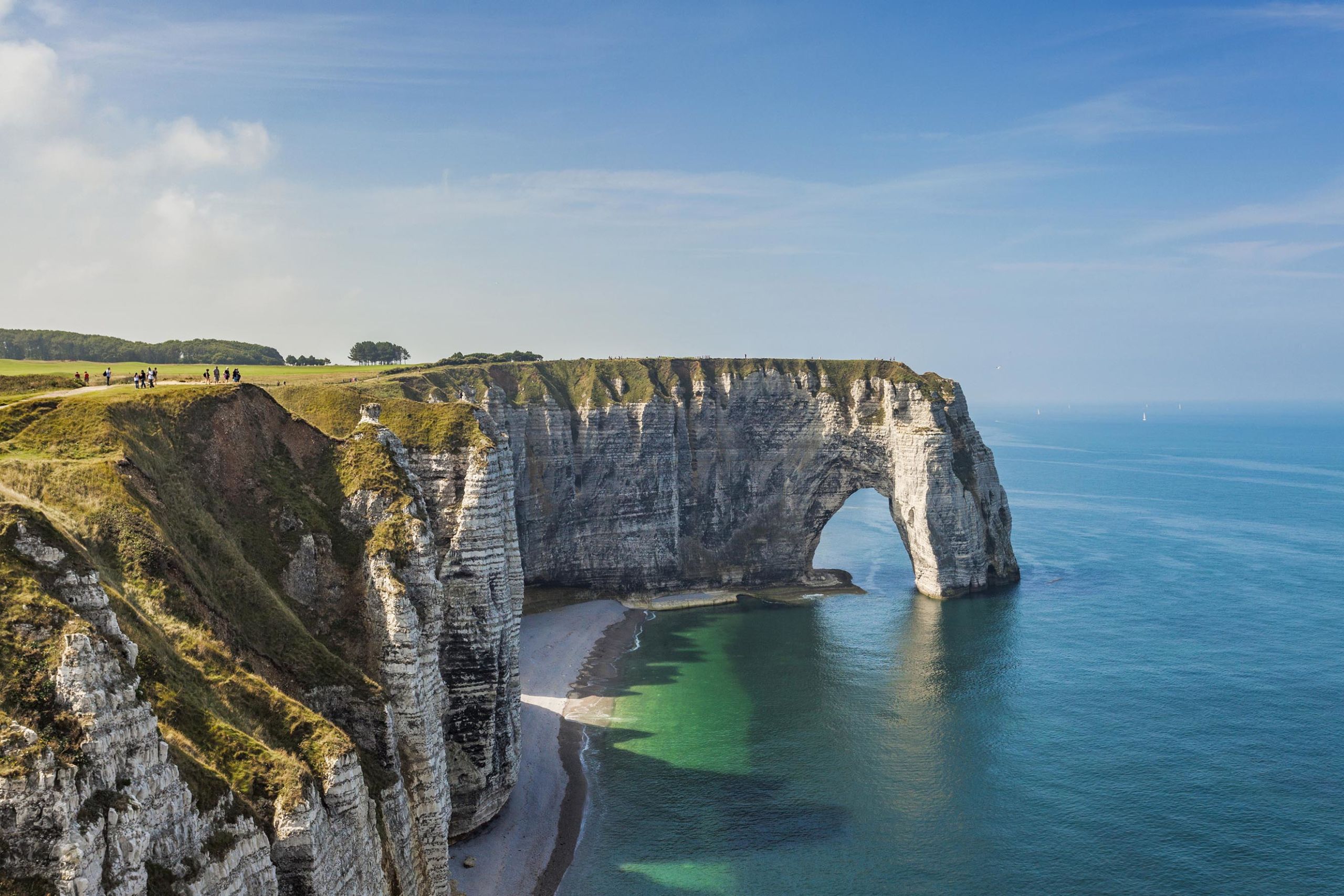
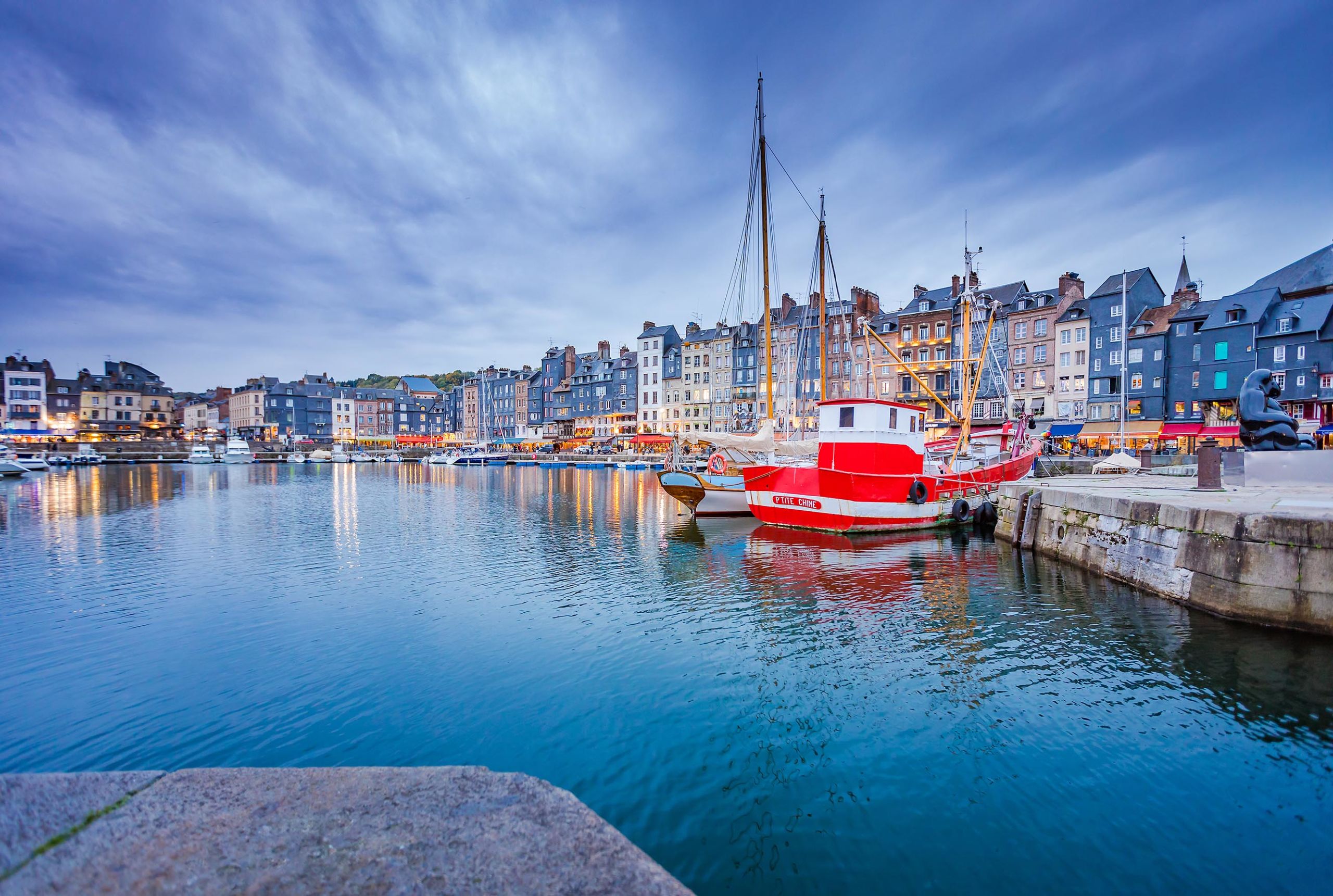
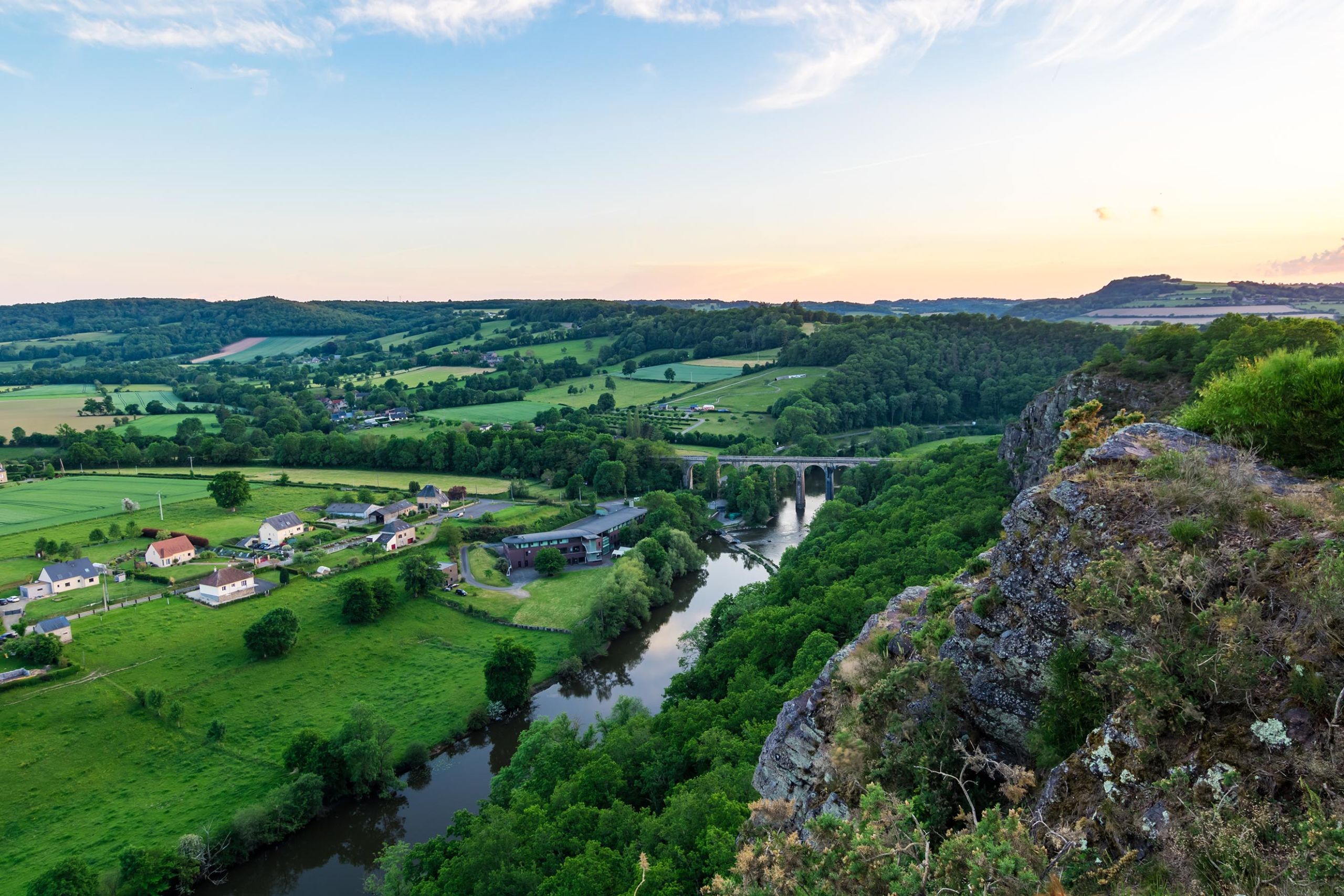
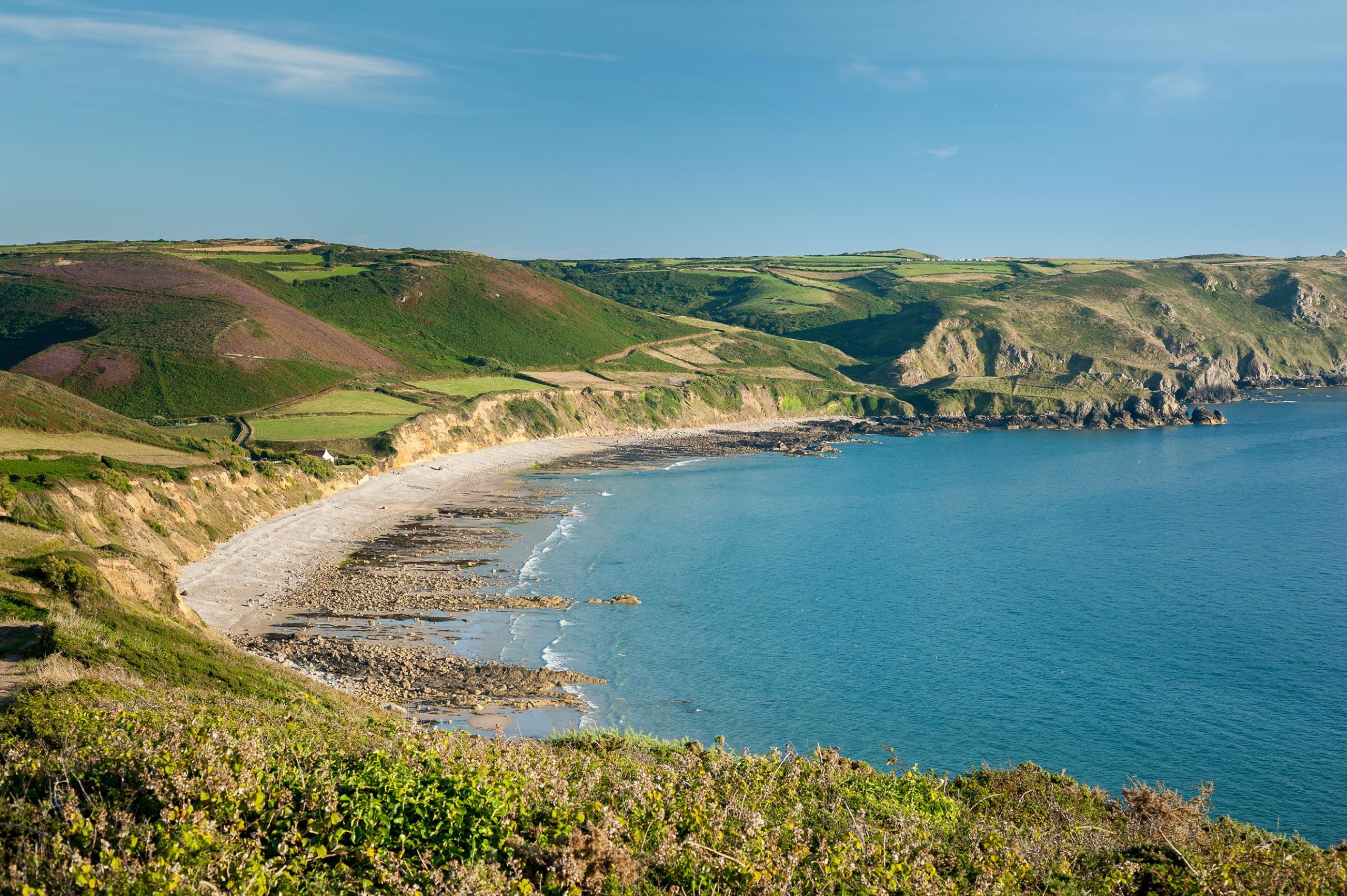
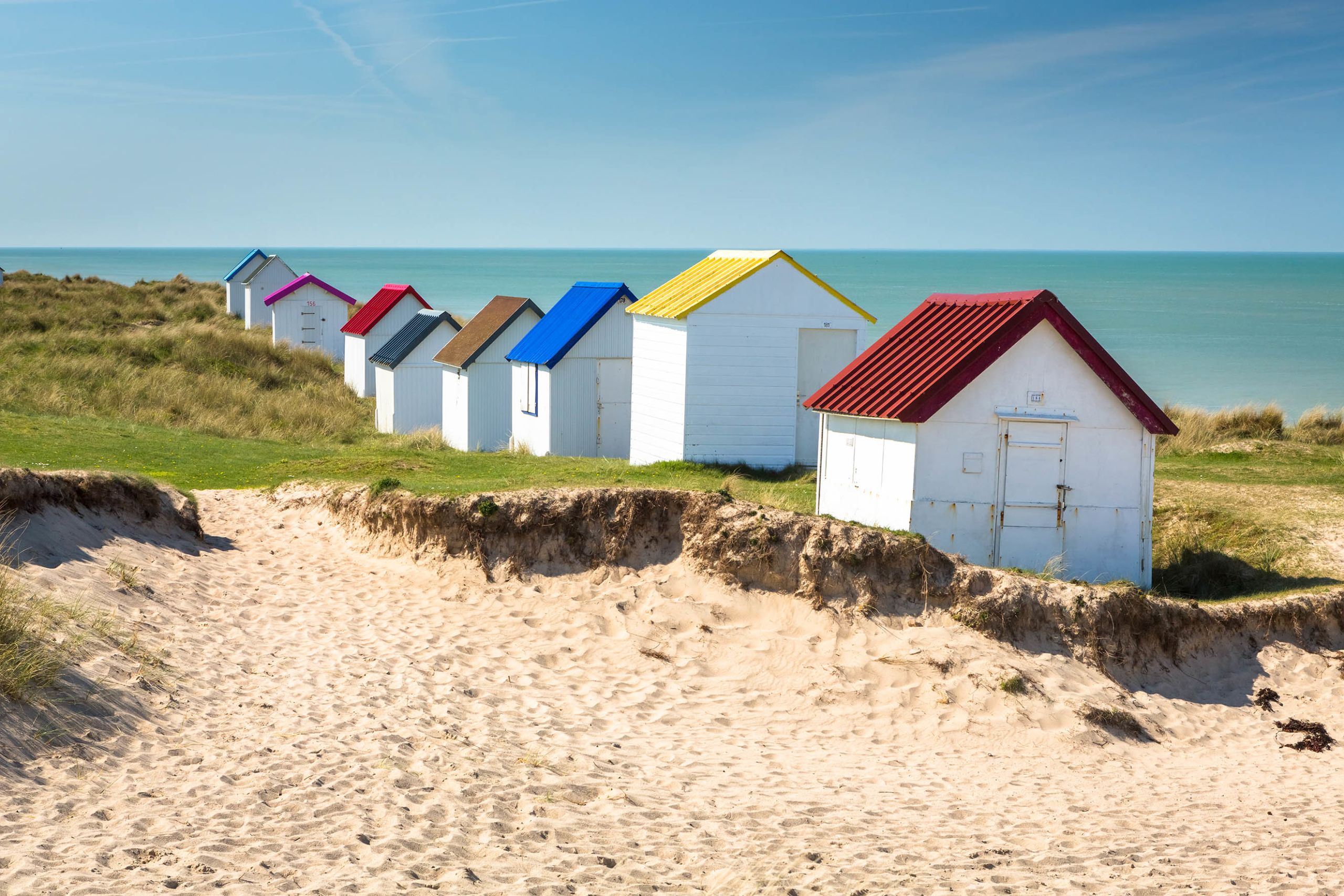
6. Granville to Cap Fréhel
Distance: 124km (by car)
The mighty GR34 walking route follows over 2,000km of the jagged coastline from Mont-Saint-Michel around to Saint Nazaire at the mouth of the River Loire. One of its most dramatic sections is just west of Saint-Malo on the Emerald Coast, so called for the sea’s deep green hue. Pace along the paths that stretch out along the gorse-and-heather-scented headland Cap Fréhel. Perched on the rocks at its tip is the partly ruined Fort la Latte, a 14th-century castle that reveals views of the cliffs below from the top of its tower.
7. Cap Fréhel to Monts d’Arrée
Distance: 155km (by car)
Head west into Brittany’s remote heartland where the region’s highest peak, the Roc’h Ruz, is just 385m above sea level. But what the surrounding Monts d’Arrée lack in altitude they more than make up for in their rugged beauty. Climb the rocky ridges and peaks, not missing the most scenic of all, the Montagne St-Michel (not to be confused with Mont-Saint-Michel). At the top of this rounded hill, a tiny chapel has been battered by the elements since it was constructed in the 17th century. The 360° views of the green landscape will help you realise just how unspoiled Brittany is.
8. Monts d’Arrée to Crozon
Distance: 60km (by car)
From there, it’s under an hour’s drive to the Crozon Peninsula at the far west of Finistère, where you can take to the water by kayak. Paddle in and out of the hidden caves and crevices between the cliffs and admire the curiously shaped rocks. Back on dry land, walk the heather-clad headlands on this cross-shaped peninsula that juts out into the swirling Iroise sea. Stop for a picnic or a swim in the azure waters off the beach at Camaret-sur-Mer.
9. Crozon to Lorient
Distance: 133km (by car)
Onward to southern Brittany, where the gentle weather lends itself to coastal walks along the sandy beaches. Strike out to the Île de Groix with a 45-minute ferry ride from Lorient and hire bikes at the harbourside in Port Tudy. Spend the day pedalling some of the more than 40km of cycle trails that pass moorland, ancient megaliths, cliffs and coves. Back on the mainland, there’s also the curious Plage des Grands Sables, a convex beach that keeps moving further north-west due to the winds and tides, earning it the nickname ‘The Wanderer’.
10. Lorient to Quiberon
Distance: 44km (by car)
Around a 40-minute drive south heralds the start of the Grand Site of Gâvres-Quiberon, a chain of sand dunes that stretch uninterrupted for 35km and marked by a rocky headland at each end. The dunes are at the whim of the wind and tides, shape-shifting on their say so. Tucked between them are lakes and mudflats that provide a habitat for much flora and fauna including rare orchids and the curry plant. Further south, on the Presqu’Ile de Quiberon, a stringy peninsula that dangles off the south coast, you can enjoy the swell of the waves during a surf lesson.
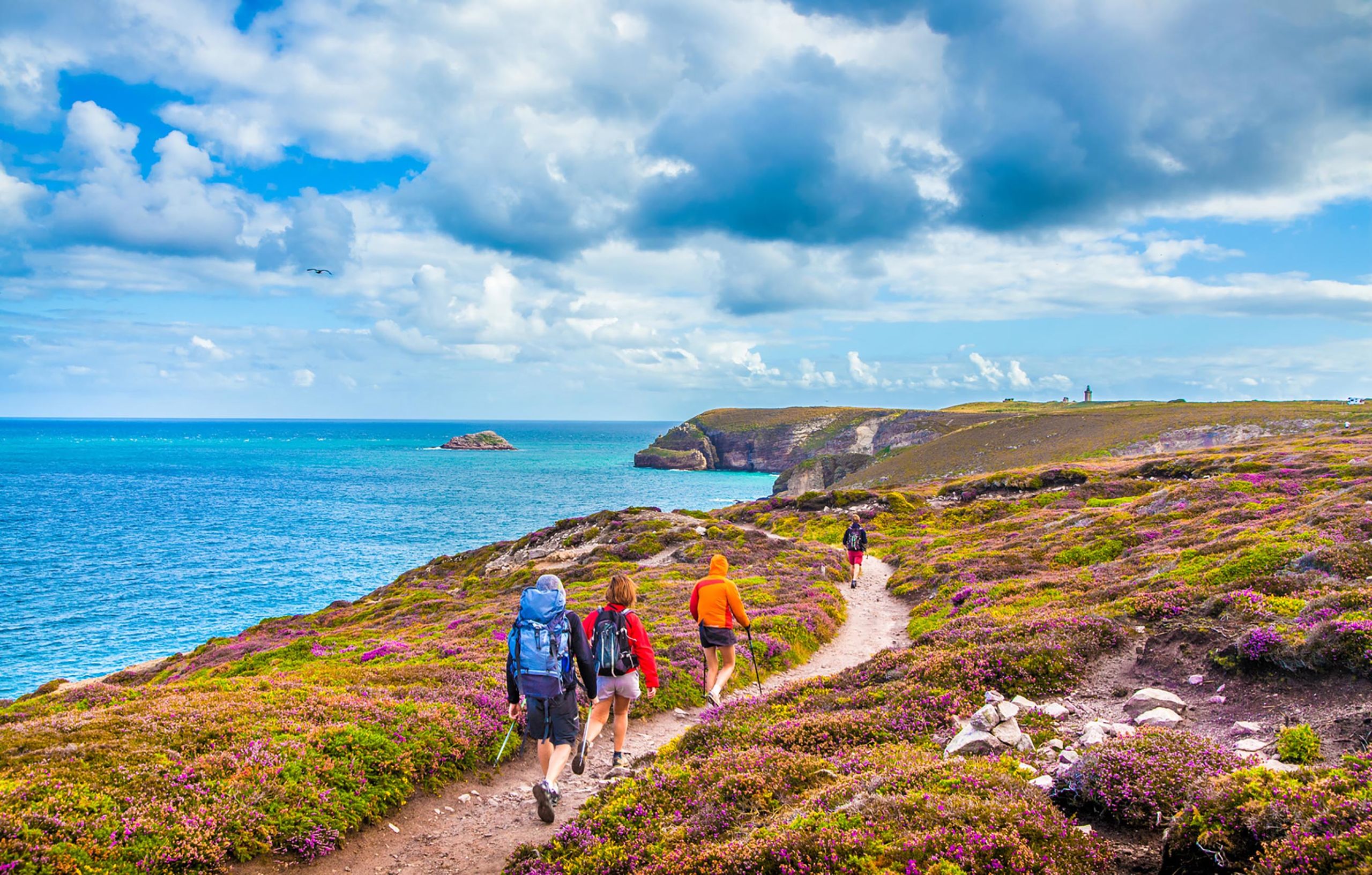
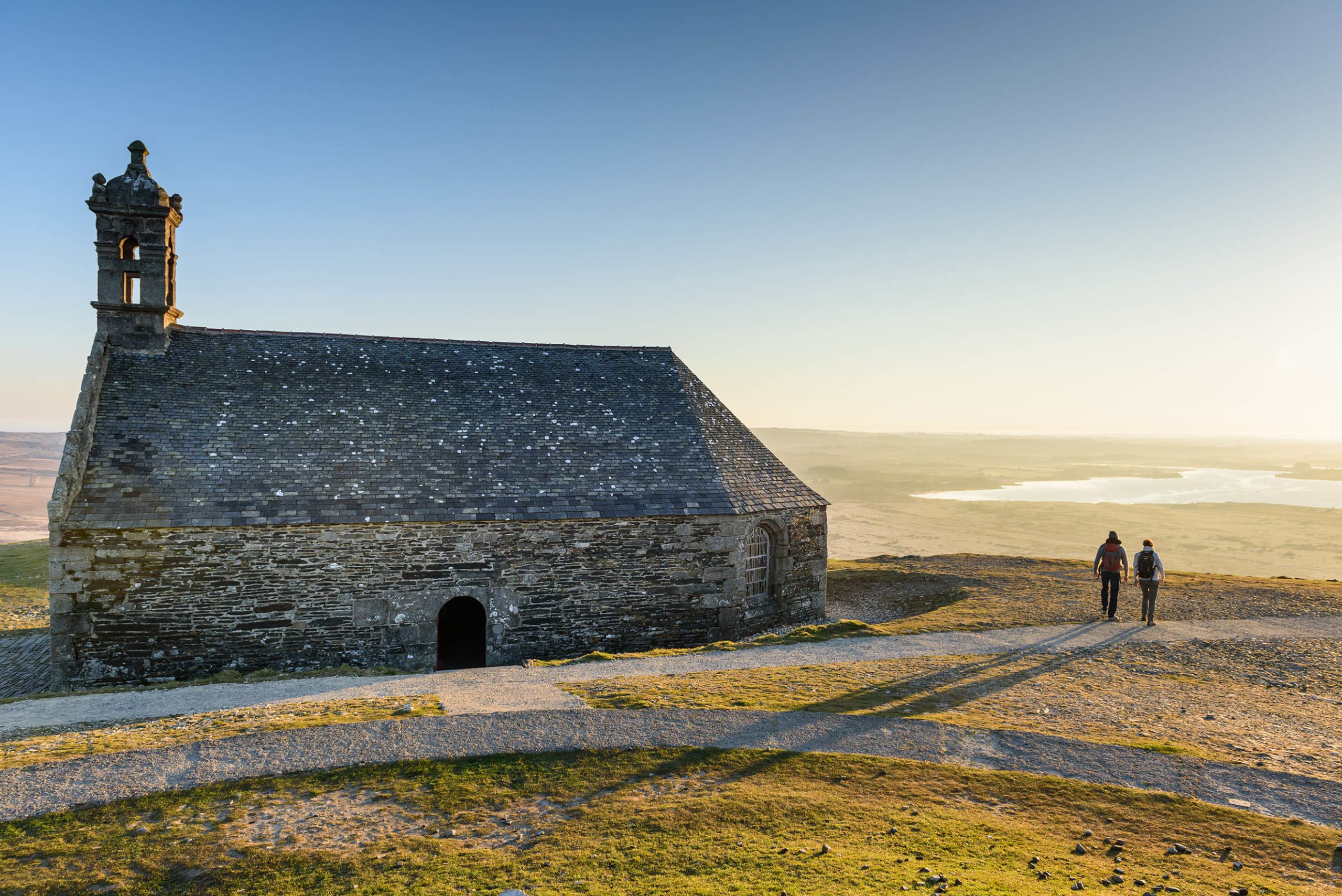
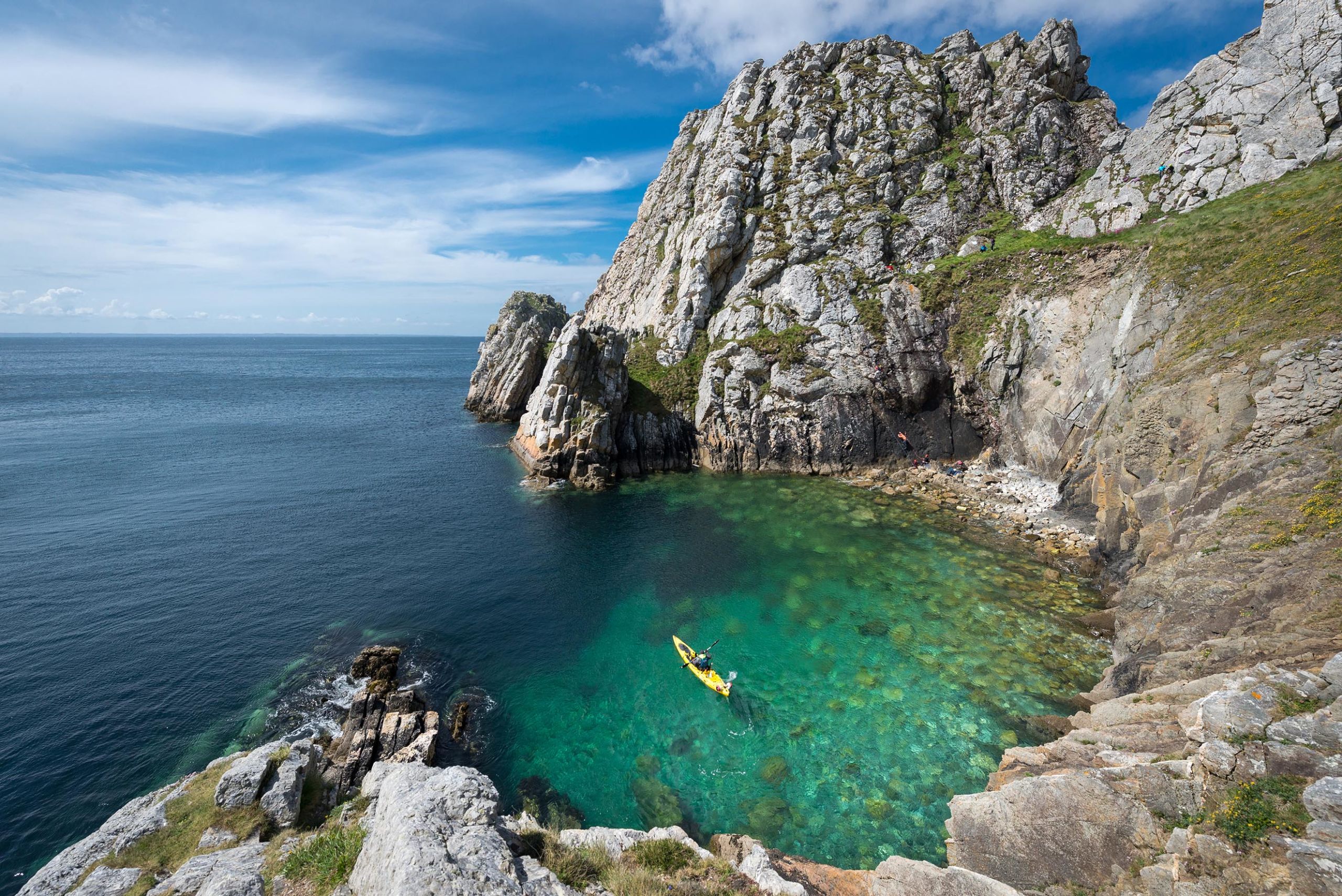
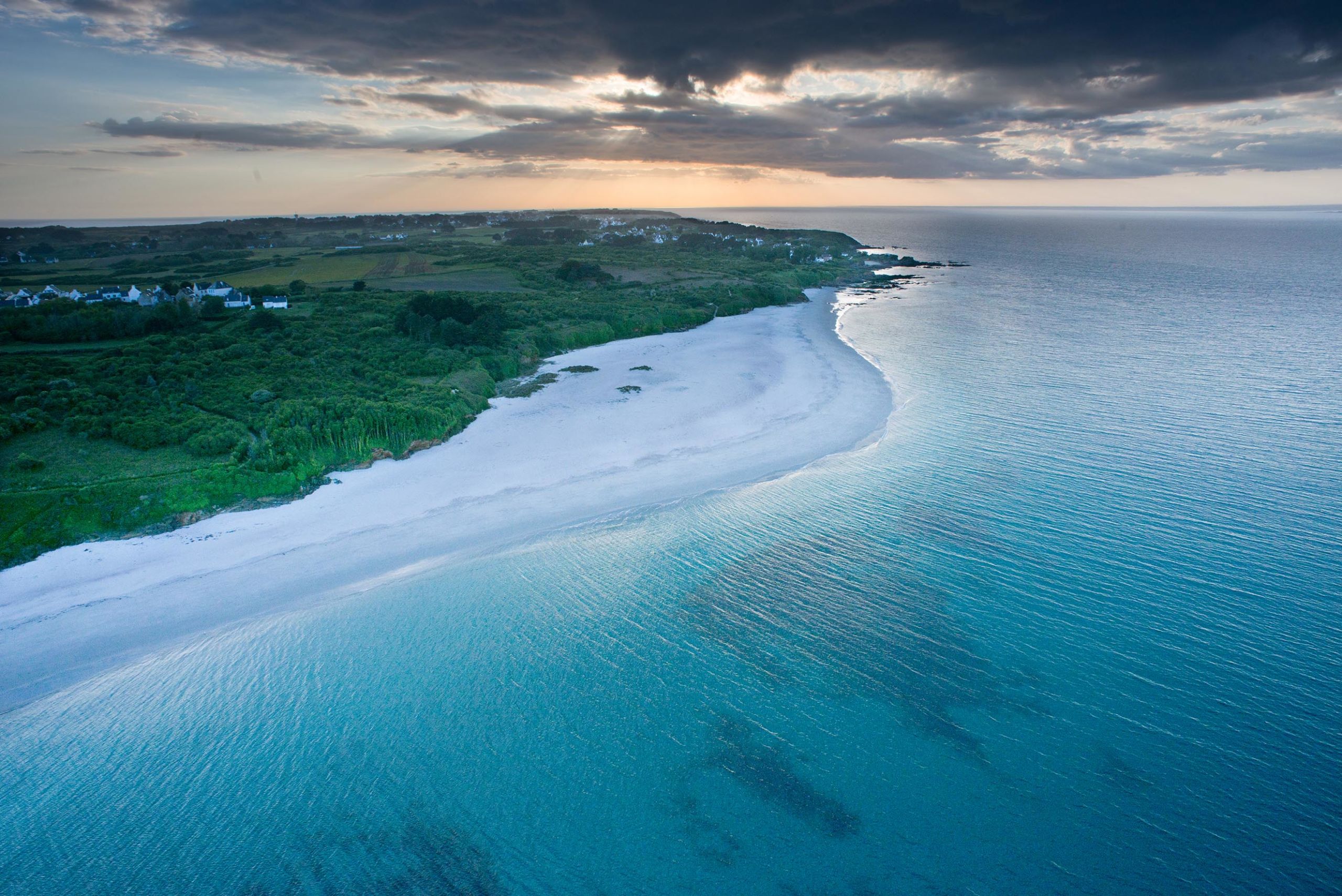
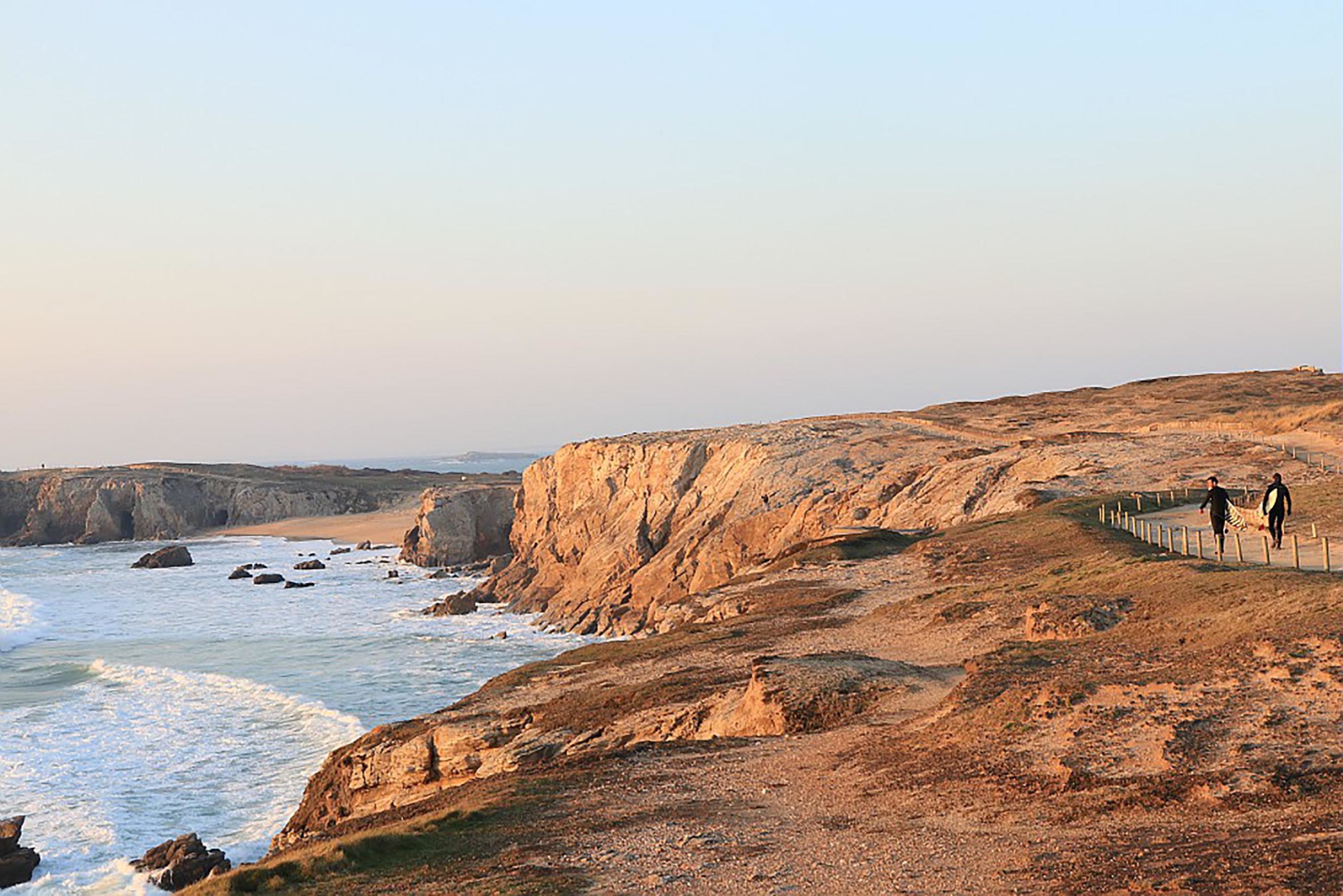
11. Quiberon to Île d’Yeu
Distance: 220km (by car)
Next, the route curls around the coast to Vendée. At Fromentine, a 30-minute ferry takes you to the Île de Yeu, a car-free island where you’ll discover its low-rise, white-washed cottages with their terracotta roofs. Explore by bike and see the wilder west coast, where you’ll find coves, rocky escarpments, the rambling fort known as Vieux Chateau and, overlooking it all, the Grand Phare lighthouse. Nature rules supreme here with over 760 plant species (look out for the rare wallflower) and almost 300 species of birds including gannets in autumn and warblers in spring.
12. Fromentine to Lac de Grand-Lieu
Distance: 55km (by car)
Birdwatchers will love the next stop too: further inland in the Loire-Atlantique department, the Lac de Grand-Lieu on the plains of the River Loire was once owned by perfumer Guerlain, who donated it to the state. It’s home to some 270 bird species, including grey herons, egrets and kingfishers, as well as birds of prey such as the marsh harrier. Explore some of the 72km path around it by bike, horseback or on foot and discover more about the area’s natural history at the Maison du Lac de Grand-Lieu visitor centre.
13. Lac de Grand-Lieu to Rochemenier
Distance: 157km (by car)
Follow the River Loire east from Nantes towards Saumur to discover the unusual underground world of the troglodytes. The Rochemenier Troglodyte Museum shows how communities lived in the hollowed-out caves from the 17th century right up until the 20th century. Explore the 13th century underground chapel, farm dwellings and multi-roomed houses carved out of the rock. Elsewhere in the area’s caves is the intriguing mushroom museum that grows an array of fungi, the underground restaurant Les Nobles Fouées and L’Hélice Terrestre, a sculpture gallery. You can also take your time and cycle the famous Loire by following the bike route.
14. Rochemenier to Alpes Mancelles
Distance: 171km (by car)
The route north from near Saumur passes the city of Angers, which is a great base from which to explore the rivers Loire, Maine, Mayenne and Sarthe by bike. Along each of the four rivers are cycle paths that allow you to enjoy the countryside away from the main roads. Pedal alongside the waterways passed vineyards, parkland and remnants from the Medieval times. Stop for refreshments at the various waterside cafés known as guinguettes, which serve simple menus at their outdoor tables, for instance alongside the famous Velofrancette route, before continuing up into the hilly landscape of the Alpes Mancelles.
15. Alpes Mancelles to Caen
Distance: 140km (by car)
Before heading home, squeeze in one more adventure at the Alpes Mancelles, a mini-mountain range that straddles the Mayenne, Sarthe and Orne departments. With some 300km of rambling routes criss-crossing the area, hikers will be spoilt for choice. Don’t miss the trek up Le Mont des Avaloirs (416m) for views over the forests and the patchwork of fields that disappear into the horizon. There are also mountain bike trails and tree-top circuits, and along the River Sarthe, you can canoe, kayak and fish. From there, it’s less than two hours north back to Caen’s port to board Brittany Ferries’ service back to Portsmouth, either overnight or for a day on deck and relaxing in their lounges and bars.
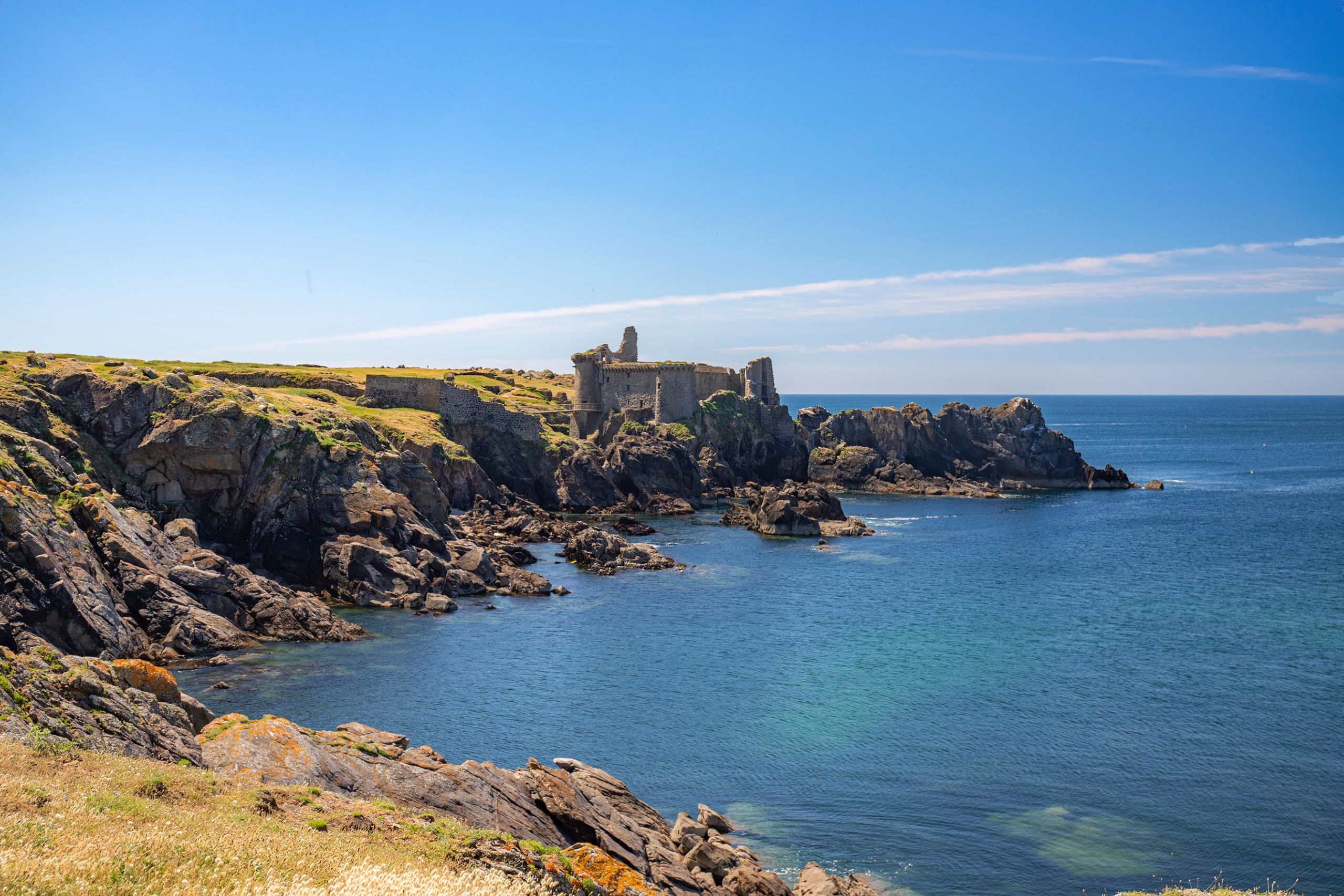
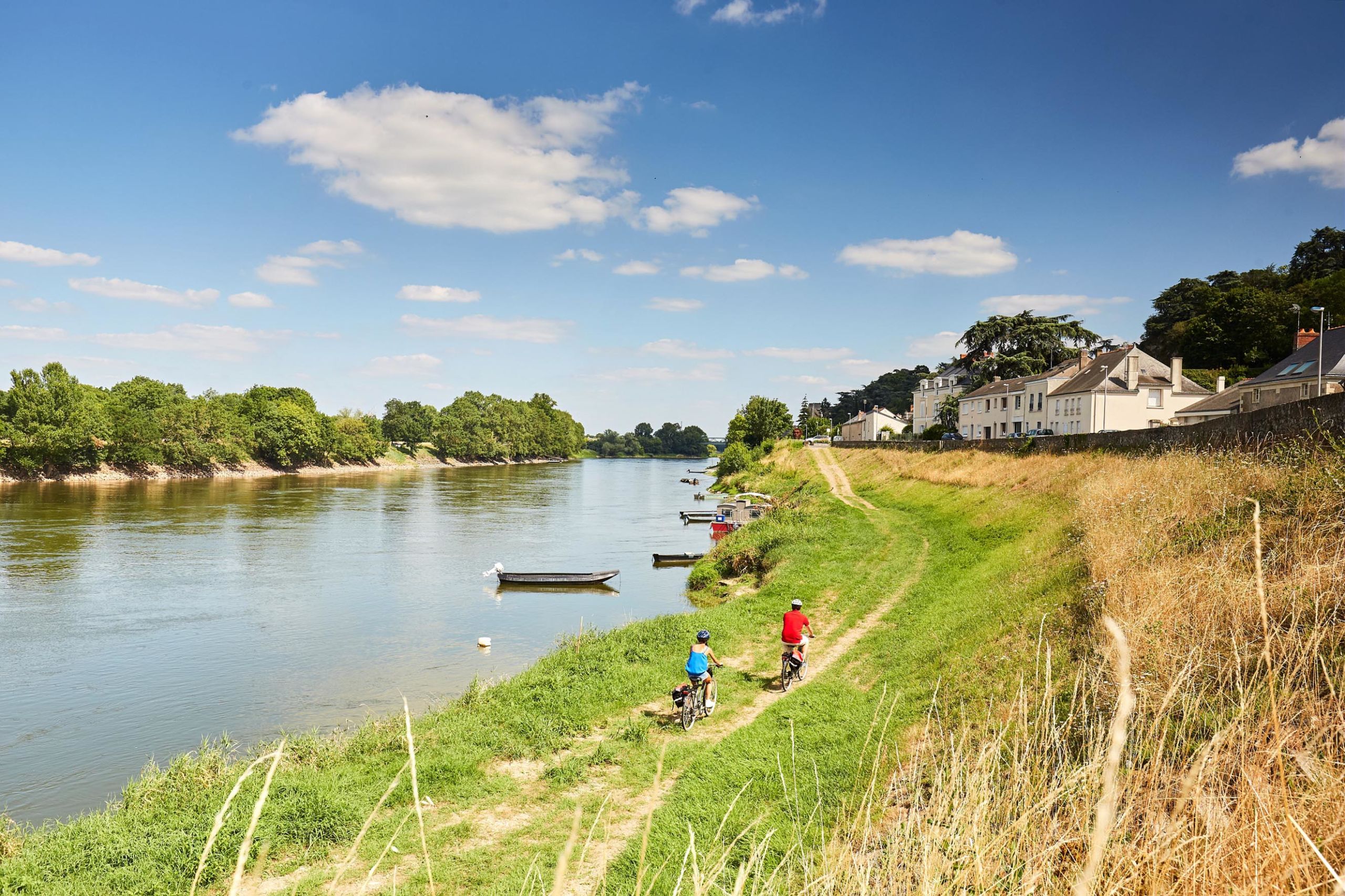
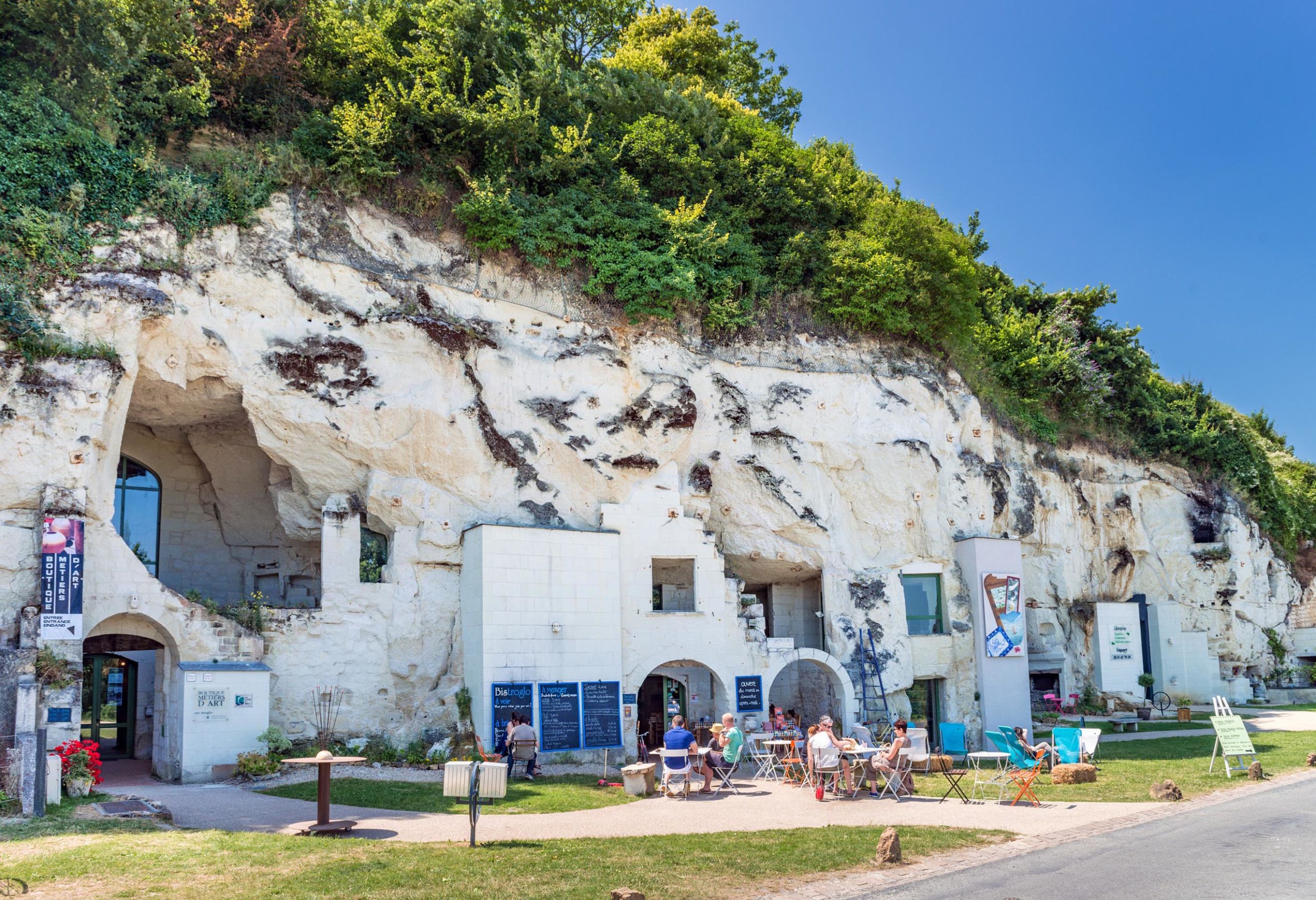
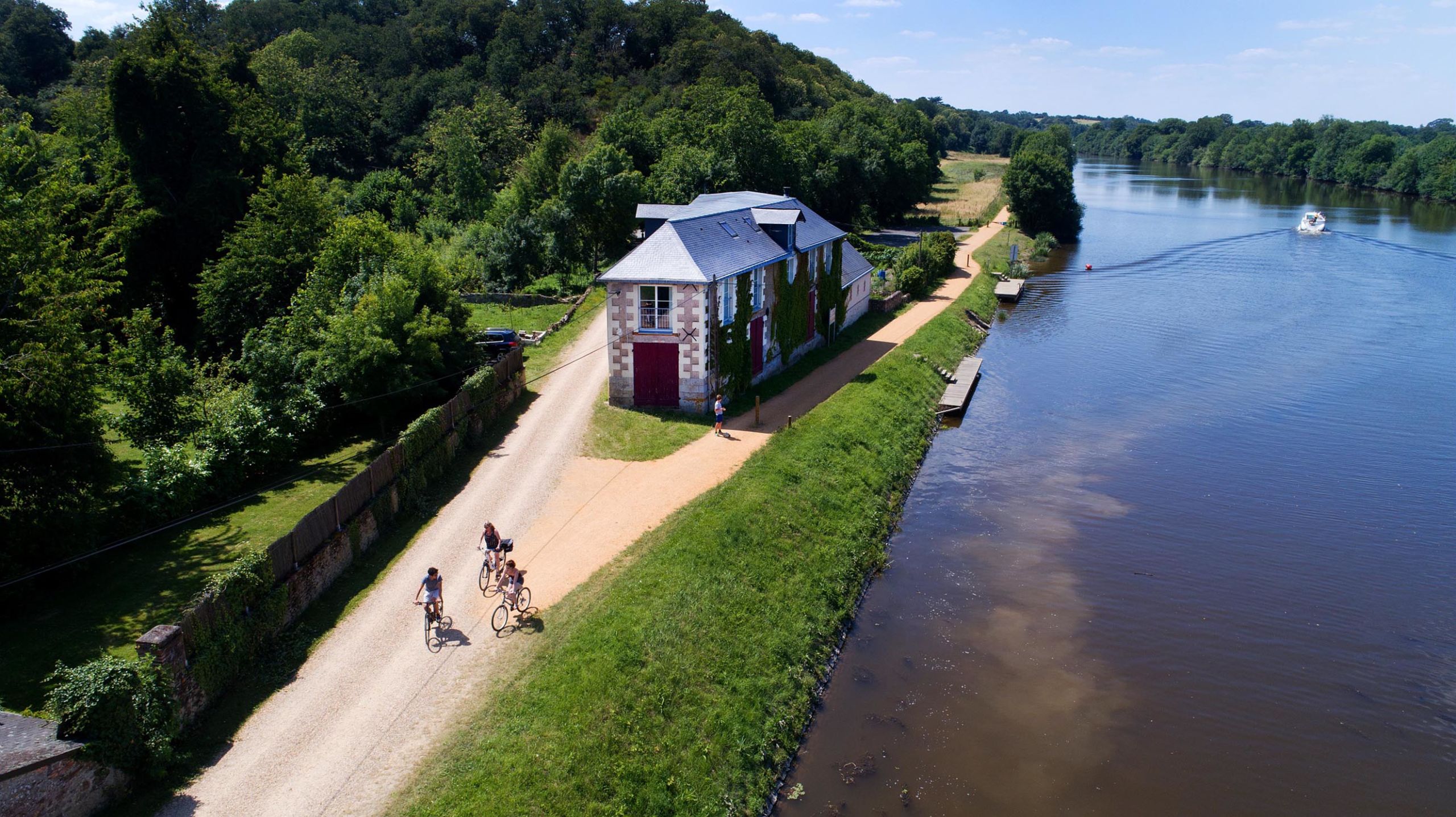
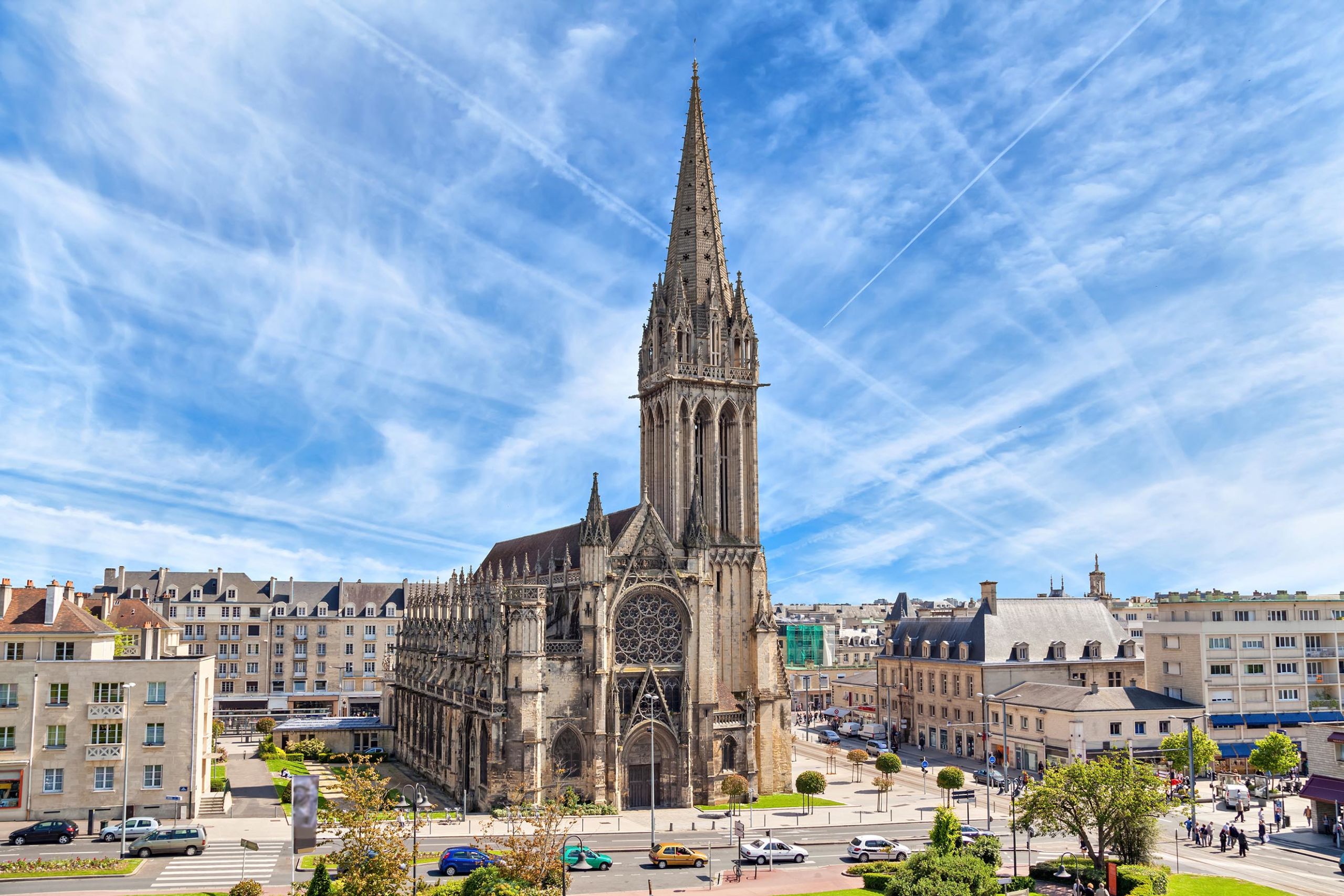
Road trip two: The road to culture
Epoch-blurring architecture, art-stuffed
villages and D-Day history await…

1. Roscoff to Île Vierge
Distance: 56km (by car)
After a night in your own cabin aboard Brittany Ferries, stroll along Roscoff’s harbour-front before heading west along the Côte des Sables, watching the golden beaches unfold in your rear-view mirror. From Aber Wrac’h, a five-minute boat (or 45 minute walk at low tide) takes you to the Île Vierge, home to Europe’s tallest stone lighthouse at over 80m. It’s one of four that make up La Route des Phares (lighthouse trail) around the far west of Finistère along with the Pointe de Saint-Mathieu, the Trézien Light and the Stiff Lighthouse. Elsewhere, book in for a stay like no other: near Audierne in south-west Finistère, the Semaphore de Lervily is a renovated lighthouse keeper’s house that sleeps eight, while the Phare de Kerbel’s bedroom is set in the octagonal glass lantern room overlooking the Quiberon peninsula in southern Brittany.
2. Île Vierge to Brest
Distance: 31km (by car)
Under a 40-minute drive south lands you in Brest, a town known for its links to the ocean. Don’t miss Les Ateliers des Capucins, where an ancient convent that was converted into industrial workshops has now been transformed again into the largest covered public square in Europe. Inside, there are cafés, restaurants and a brewery as well as boutiques and galleries, and even an indoor climbing wall. Arrive in style at the complex by cable car from the other side of the River Penfeld for a bird’s eye view of the city and its harbour below.
3. Brest to Quimper
Distance: 70km (by car)
You’ll spot the twin spires of Quimper’s cathedral from a distance, and they’ll lead you to the heart of this culture- and history-stuffed town. Visit the Musée Départemental Breton, set in the former Bishops’ Palace for an insight into the region’s heritage through the traditional costumes, as well as art, ceramics, sculptures and furniture on display. Walk the narrow, medieval streets to browse the town’s boutiques before calling into a crêperie for a true Breton meal – a buckwheat galette (a savoury pancake usually filled with spinach, cheese and egg) and a cup of cider.
4. Quimper to Pont Aven
Distance: 35km (by car)
Follow the slower road (the D783) to Pont Aven, stopping at Concarneau on the way to roam around its ramparts. Continue to Pont Aven, set on the river that gave the town its name and also inspired generations of artists, including Paul Gauguin who stayed in the village several times. It was here that he met fellow artist Émile Bernard, leading to the start of the École de Pont-Aven. This saw the beginning of an art movement that rejected traditional methods, stripping art down to its essentials and focusing more on colour and symbolism. Explore the galleries and follow the trail that marks out the spots that inspired Gauguin’s paintings.
5. Pont Aven to Rennes
Distance: 188km (by car)
Colourful paintings abound in Rennes too, just over two hours west, where a trend for street art has seen bright murals adorn walls and fences throughout the city, much of it thanks to ‘the Banksy of Rennes’ an artist named WAR! The Breton capital is also known for its mosaic art, which started with the Odorico family, who settled in Rennes in 1882. Spanning two generations of Italian artists and craftsmen, they decorated many buildings in and around the city of Rennes (and many other places in Western France, too) with intricate and colourful mosaics, including the elaborate public swimming pool, La Piscine Saint-Georges.
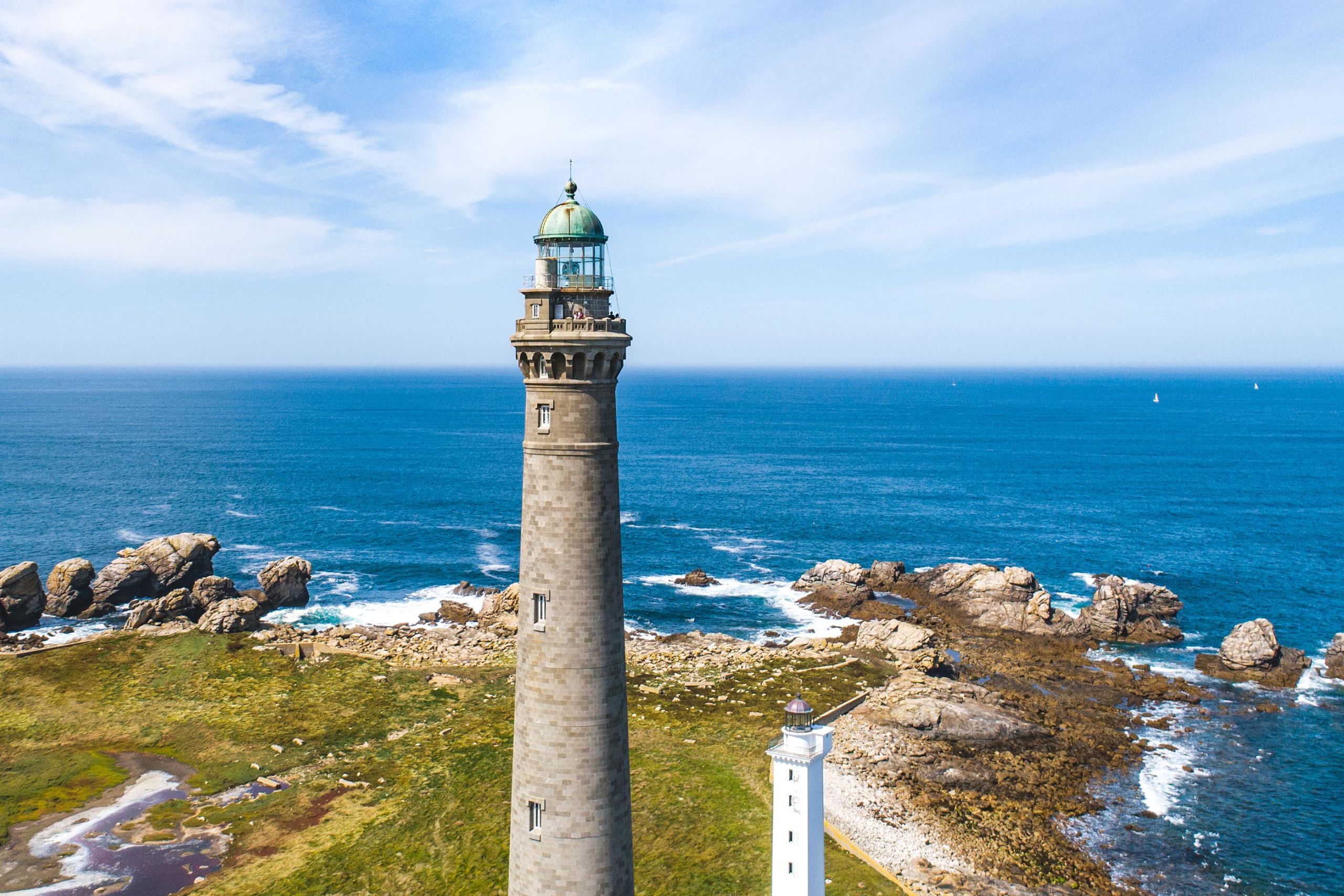
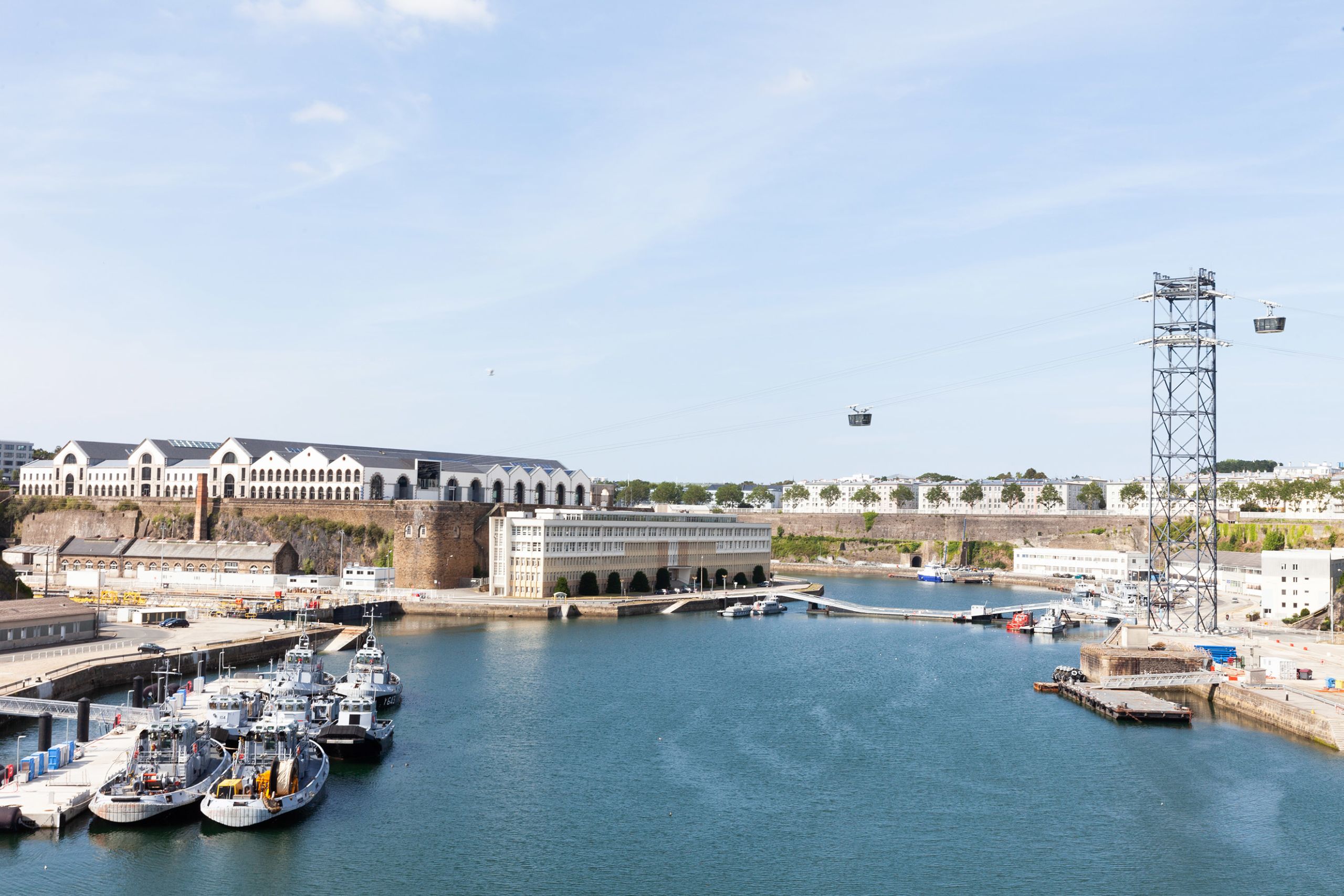
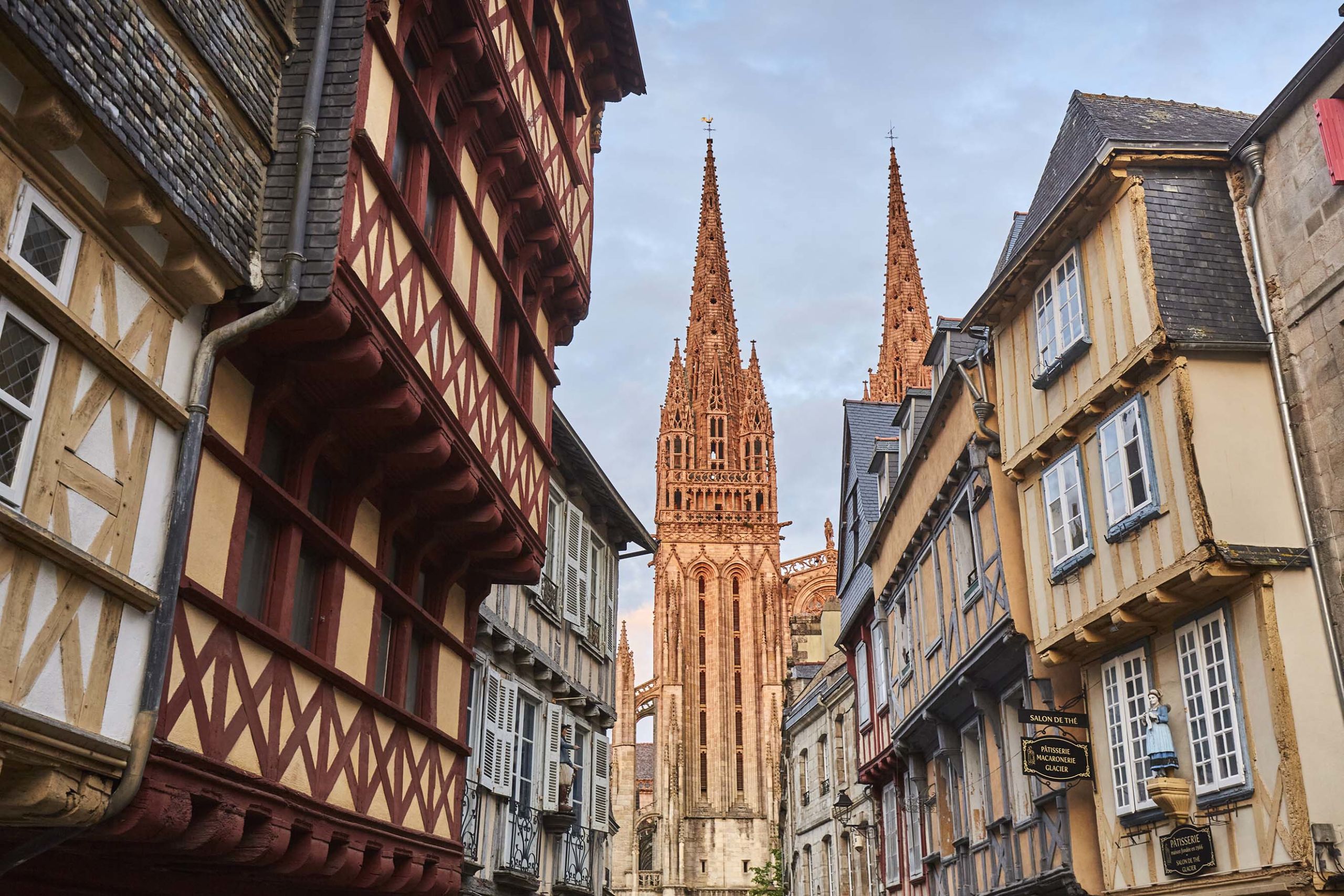
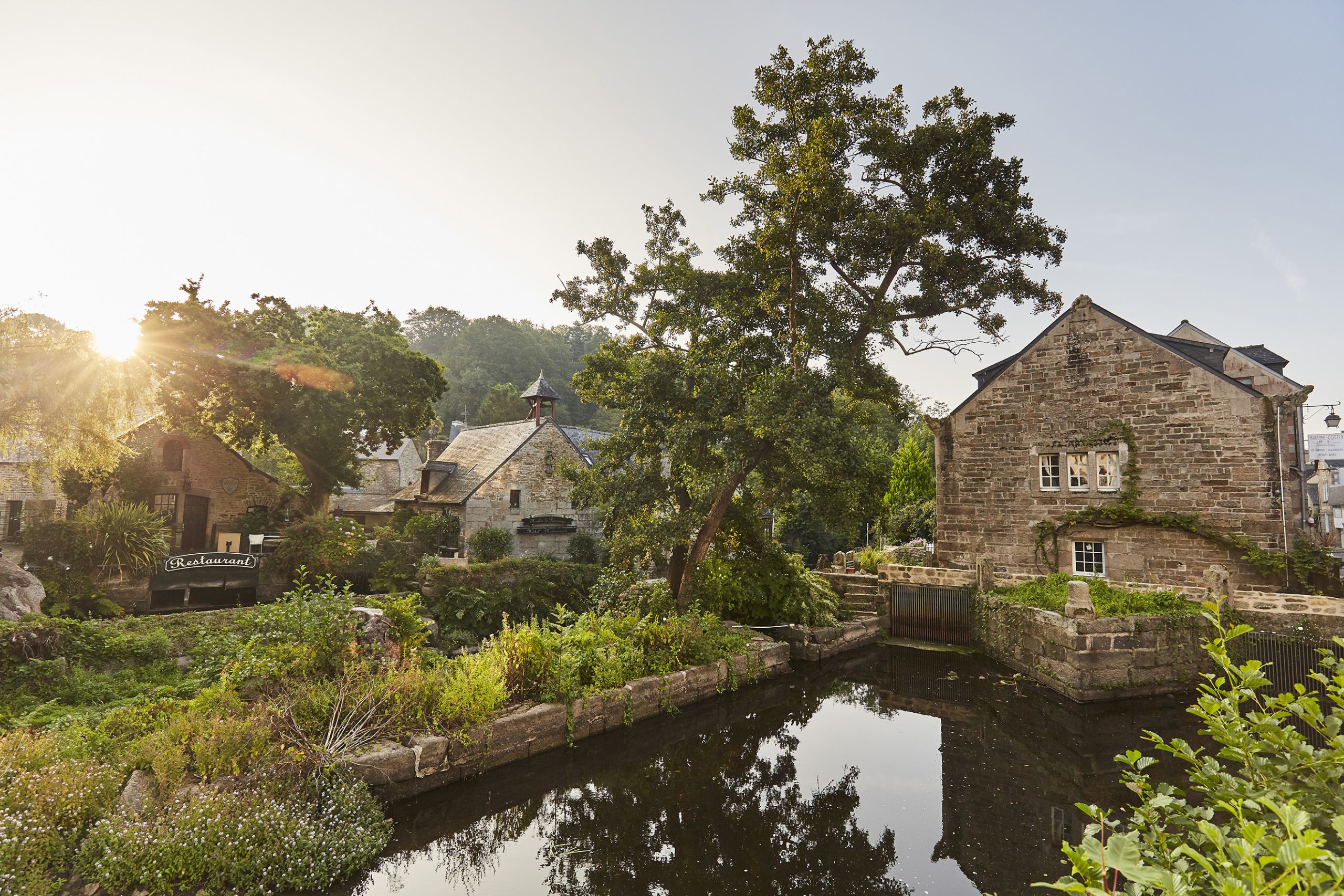
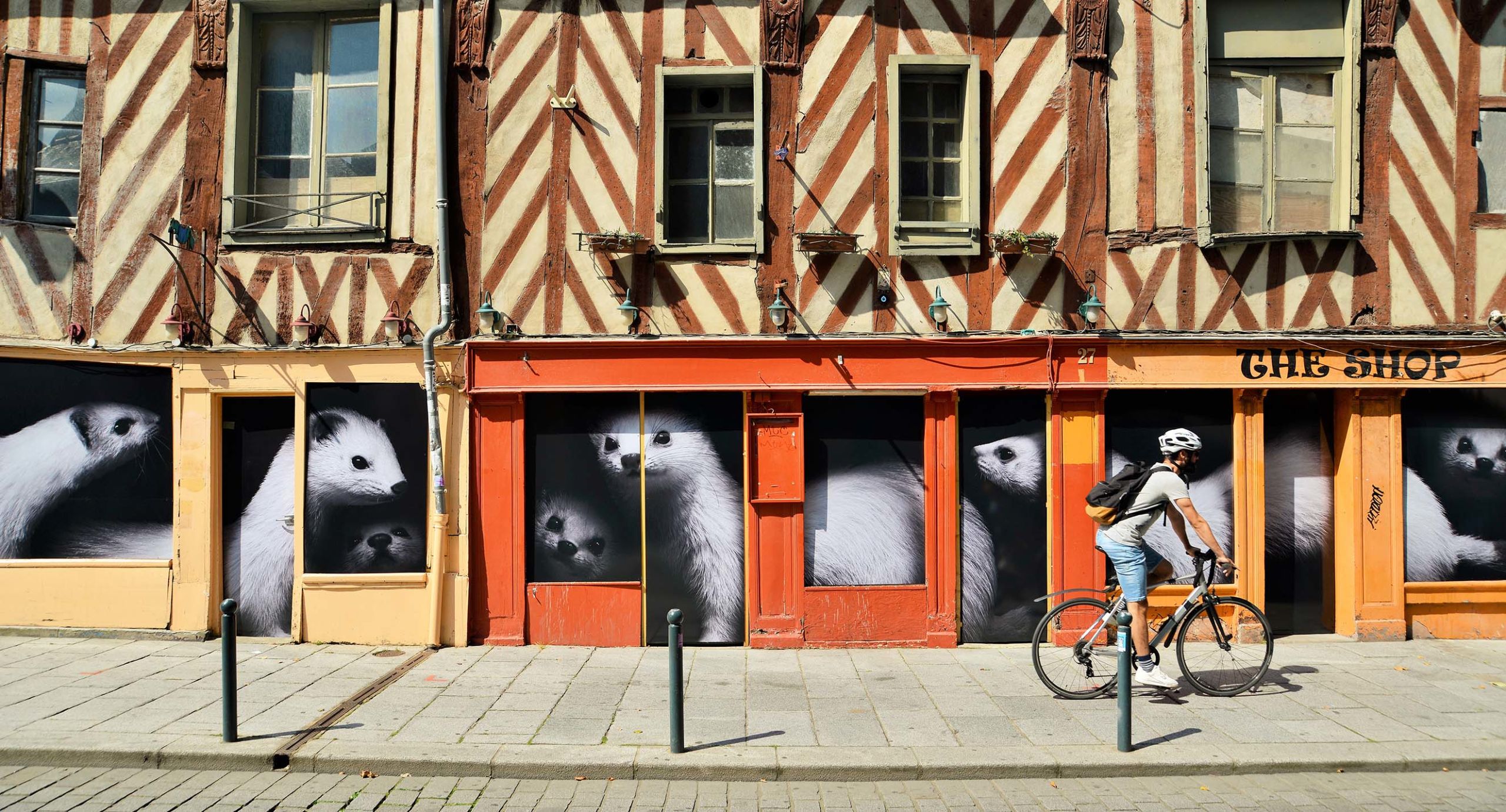
6. Rennes to Fontenay-le-Comte
Distance: 232km (by car)
The route from Rennes to Fontenay-le-Comte allows for plenty of pitstops to admire lesser-known castles and palaces along the way. In the heart of the city of Nantes, the 15th-century Chateaux des Ducs de Bretagne houses a cleverly curated museum that uses contemporary, digital methods to tell the many stories of Nantes’ history, from biscuits to shipbuilding. Around a 30 minute drive south is Clisson where you can visit the Chateau de Clisson – much of it built in the 13th century – before exploring the rest of the town’s Renaissance architecture.
7. Fontenay-le-Comte to Angers
Distance: 161km (by car)
With so many well-preserved examples of fine Renaissance architecture, a visit to Fontenay-le-Comte (dubbed the ‘fountain of beautiful minds’ by King François I) is like travelling back in time. Walk through its arcaded streets, following the trail of time-frozen mansions and manor houses such as the Sénéchaussée, the Grimouard and the Guesthouse of Beaux-Esprits. Around an hour-and-a-half’s drive north to Brissac-Quincé, the tallest castle in France awaits exploration. With 204 rooms – including a 200-seat theatre – spread over seven floors, it’s worth allowing out a couple of hours for. Over in the nearby city of Angers, its eponymous chateau is encased by 17 rotund towers and the ramparts hanging high over the River Maine.
8. Angers to Sainte-Suzanne
Distance: 94km (by car)
Start at Angers' chateau and follow the blue-painted line on the pavement to see the rest of the city’s highlights including Art Deco architecture, modern murals and Maison Adam, a 15th-century, timber-framed building with several carved figures both from mythology and the bible. An hour north, more art awaits at the Musée Robert Tatin in the Mayenne department, which opened in the early 1960s and has been intriguing visitors with its alien-like sculptures and figures ever since. Tatin’s travels in South America inspired his own imaginative world, and the park welcomes you in with the 80m-long ‘Alley of Giants’, lined with sculptures that shine a light on his artistic journey. From there, it’s around an hour’s drive to Sainte-Suzanne where its 11th-century keep looks out from high above the Erve Valley.
9. Sainte-Suzanne to Le Mans
Distance: 55km (by car)
Taking to Le Mans' Historic Quarter on foot is a relaxing way to see the Plantagenet City’s cobbled streets, Roman walls, half-timbered mansions and Gothic-Romanesque cathedral. Just outside the city, the Abbaye de l’Epau is a former Cistercian abbey established by English queen Berengaria of Navarre in 1229. Today it’s a serene place to learn about the monks who lived there until the French Revolution. Le Mans also makes a good base for seeing the chateaux of the Sarthe department such as the 15th century Chateau de Montmirail, which has been in the same family for over 600 years. Set on a gentle hill surrounded by the village, it offers views over the Perche Regional Nature Park. An hour’s drive south, Chateau du Lude began life in the 10th century but over the following centuries gained features from a variety of architectural styles including a lavishly sculptured façade, a grand example of Italian Renaissance architecture in France.
10. Le Mans to Le Havre
Distance: 209km (by car)
The journey north through the expansive countryside of Sarthe brings you to Saint-Céneri-le-Gérei. It’s categorised as one of France’s ‘Plus Beaux Villages’, thanks to its medieval chapel, Romanesque church and the River Sarthe running through, all adorned by an abundance of flowers. The peaceful scenery was much loved by artists including Corot and Courbet as well as pre-Impressionist landscape painters. Another one for the must-see list is Le Bec-Hellouin in south-west of Rouen, where its 11th-century Abbey Notre-Dame du Bec is still home to an order of Benedictine monks. From there, it’s just over an hour’s drive north-west to Le Havre.
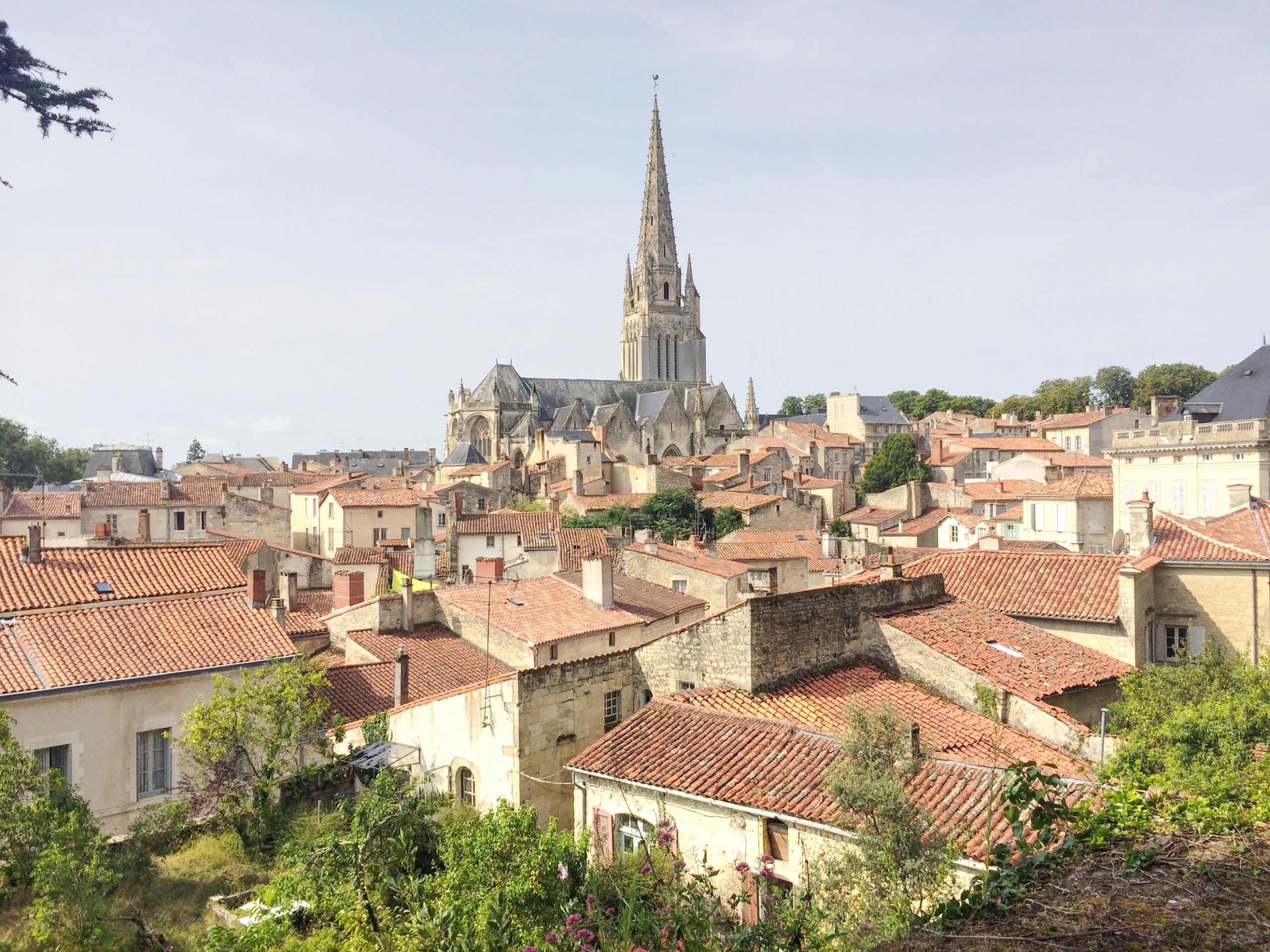
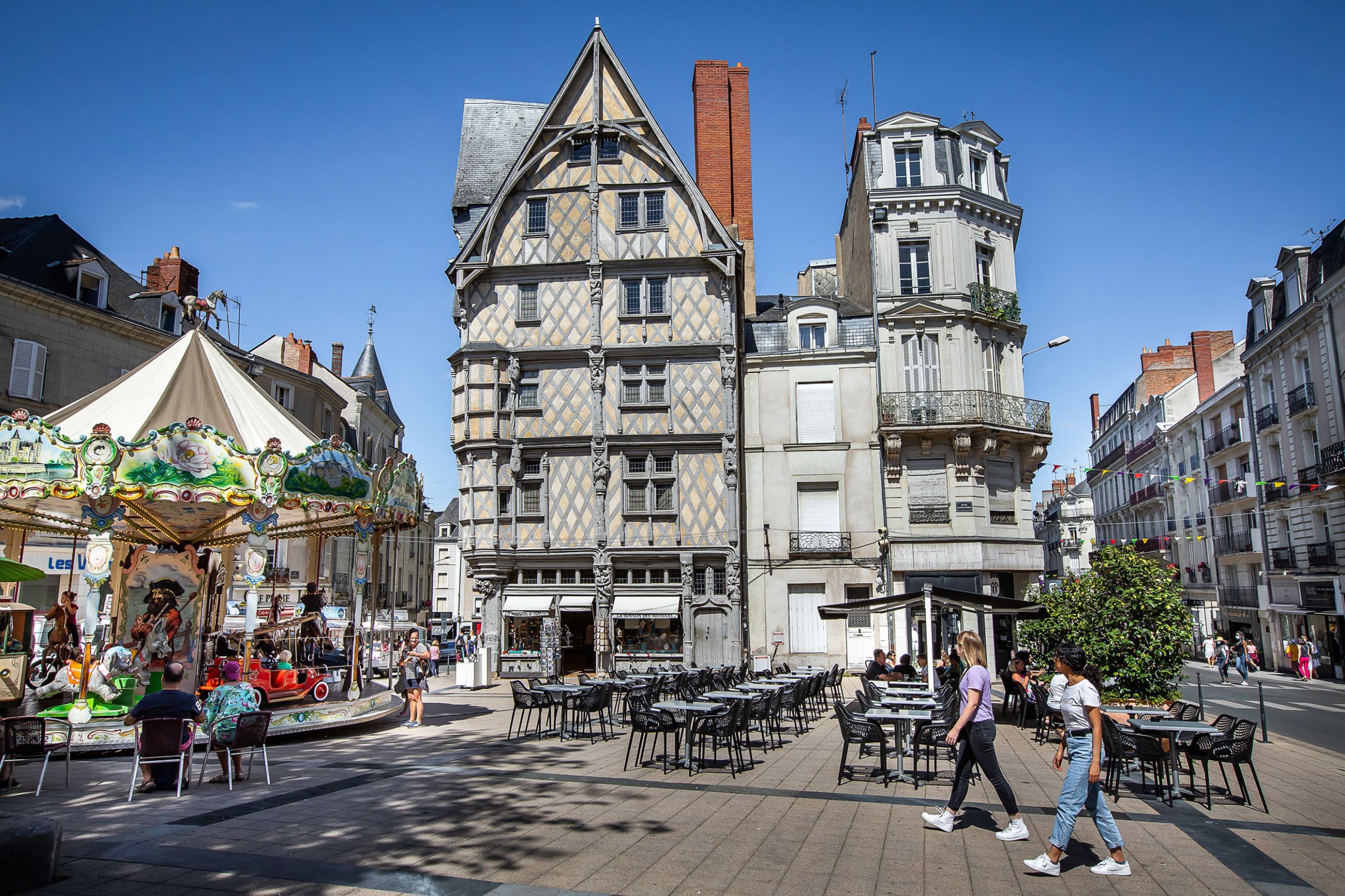
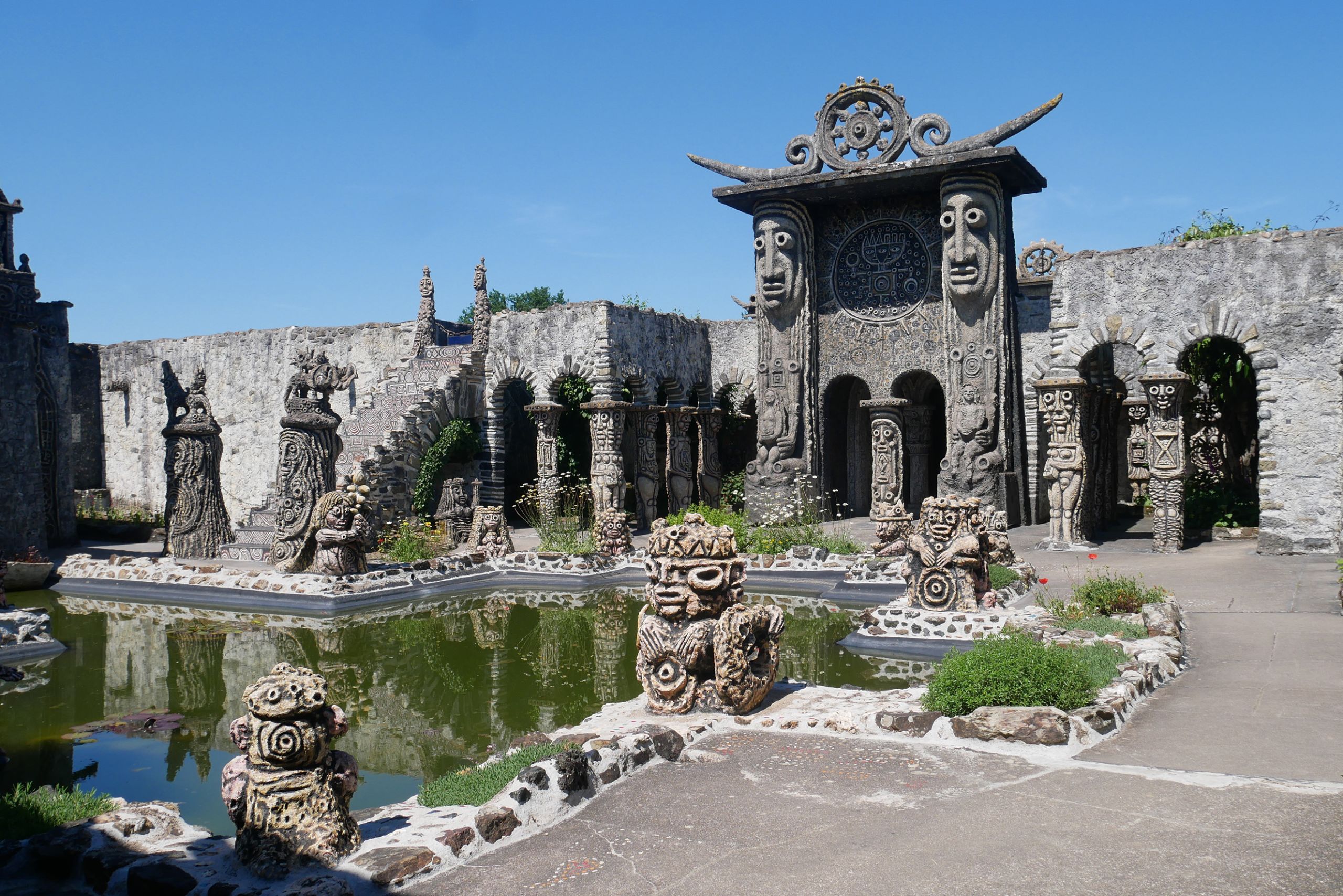
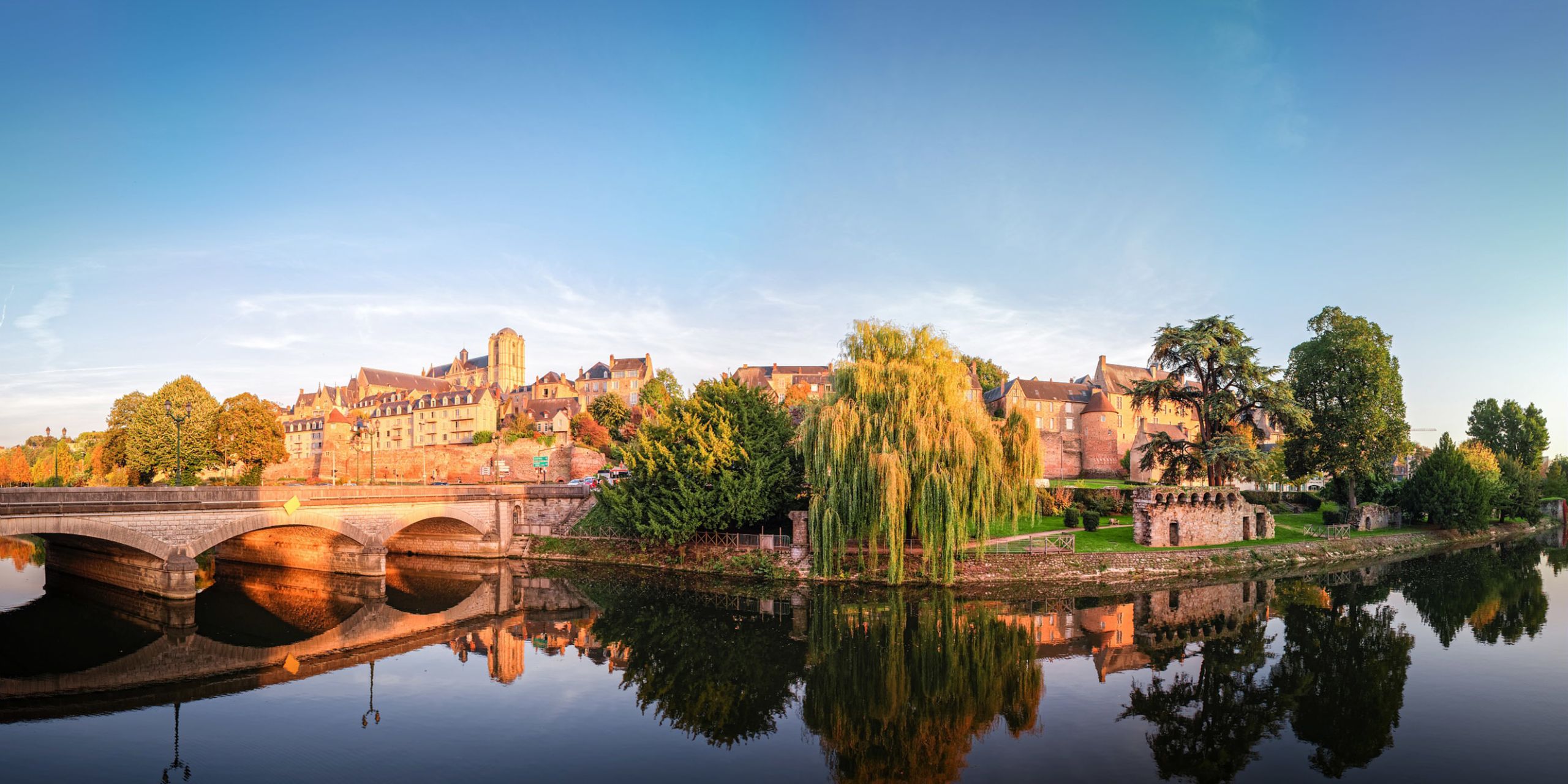
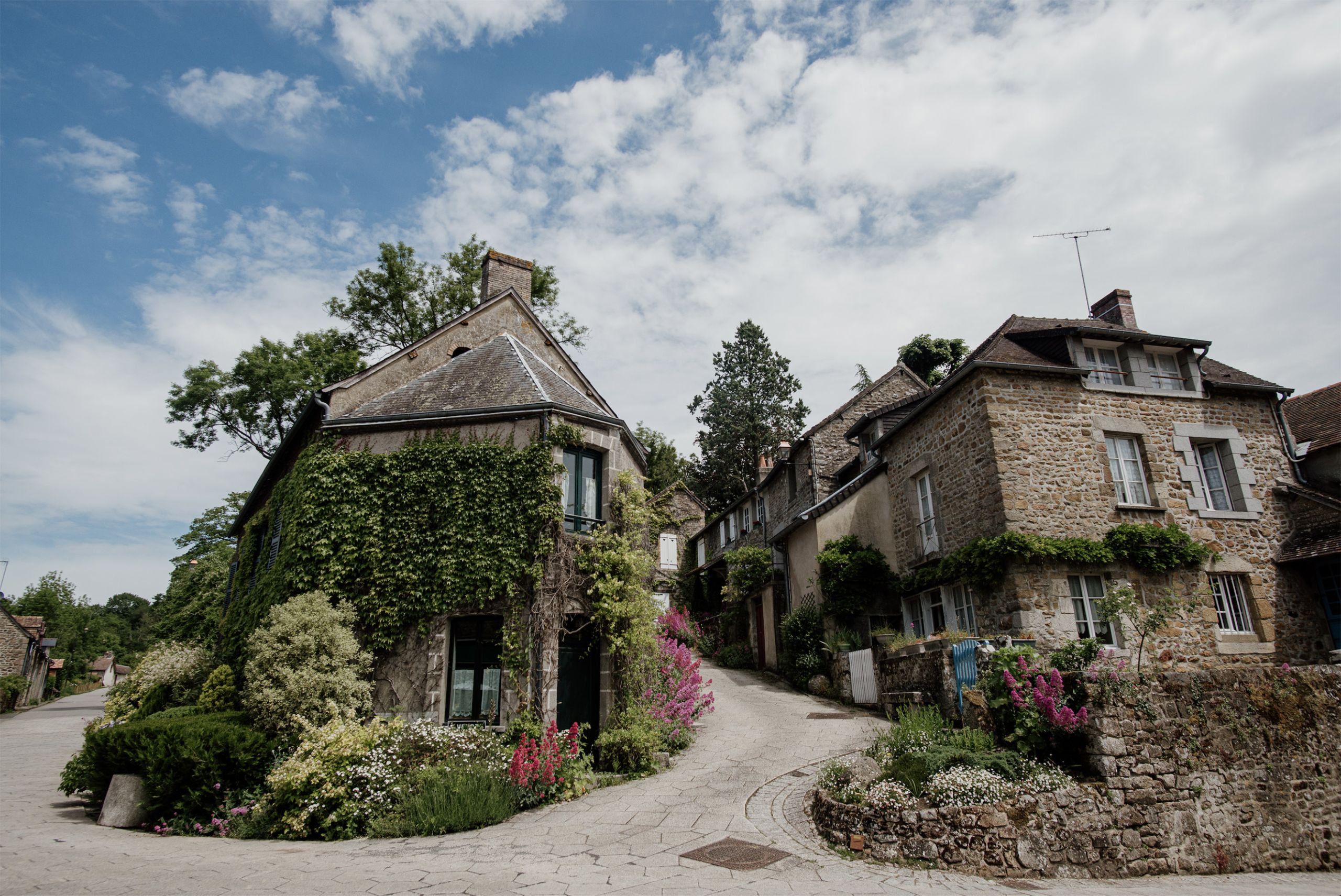
11. Le Havre to Deauville
Distance: 43km (by car)
Le Havre is something of a Brutalist beauty thanks to its post-war architecture. The whole town was flattened by carpet bombs during the Second World War and so was entirely rebuilt to a design by Auguste Perret, and the architecture has since been listed by UNESCO. As well as the surprisingly spiritual St Joseph’s Church, there’s the retro Appartement Témoin Perret, a ‘show flat’ presented as it would have looked to its first residents in the 1950s, complete with Scandi furniture (that’s now back in style). Across the mouth of the River Seine, Deauville is a step back in time to the glamorous Belle Epoque.
12. Deauville to Cabourg
Distance: 25km (by car)
Stroll the famous boardwalk along Deauville’s beach, where the bannisters that separate each beach hut bear the names of A-list stars who have attended the town’s American Film Festival. Just five minutes from the beach, the new cultural centre Les Franciscaines is set in a former convent and brings together an extensive collection of works by renowned artist André Hambourg, as well as photography exhibitions and interactive displays. Further along the coast at Cabourg, the Villa du Temps Retrouvé (The Villa of Time Rediscovered) is a new visitor centre that celebrates the culture of the Belle Epoque, focussing on the early 20th century scribe Marcel Proust, who wrote some of his weighty tome in the nearby Grand Hôtel.
13. Cabourg to Beuvron-en-Auge
Distance: 15km (by car)
Normandy’s power to inspire continues to this day and during the 2020 lockdown, David Hockney – who has lived in Normandy since 2018 – was so inspired by the apple blossom and richness of the countryside that he created a series of works that went on to become The Arrival of Spring exhibition at London’s Royal Academy. He is based near Beuvron-en-Auge, well known for its cider farms and orchards, as well as being another of Normandy’s ‘Plus Beaux Villages’. Hockney has also been inspired by the Bayeux Tapestry, which he first saw in 1967; he is now preparing to show his own over 80m ‘Bayeux-Tapestry-styled’ picture – depicting a year in Normandy – at Paris’ Musée de l’Orangerie from 13 October 2021 to 14 February 2022.
14. Beuvron-en-Auge to Caen
Distance: 36km (by car)
No visit to the Normandy coastline would be complete without learning more about D-Day. Just outside the village of Ver-sur-Mer, the newly revealed British Normandy Memorial stands overlooking the Gold Beach, one of the two beaches where British forces landed on 6 June 1944 and lists the names of more than 22,000 men and women under British command who lost their lives in the region as part of the Battle of Normandy. Elsewhere, museums and memorials tell of the intricate planning of the mission and its brave execution. From there, head to the ferry port at Caen to sail back to Portsmouth with Brittany Ferries.
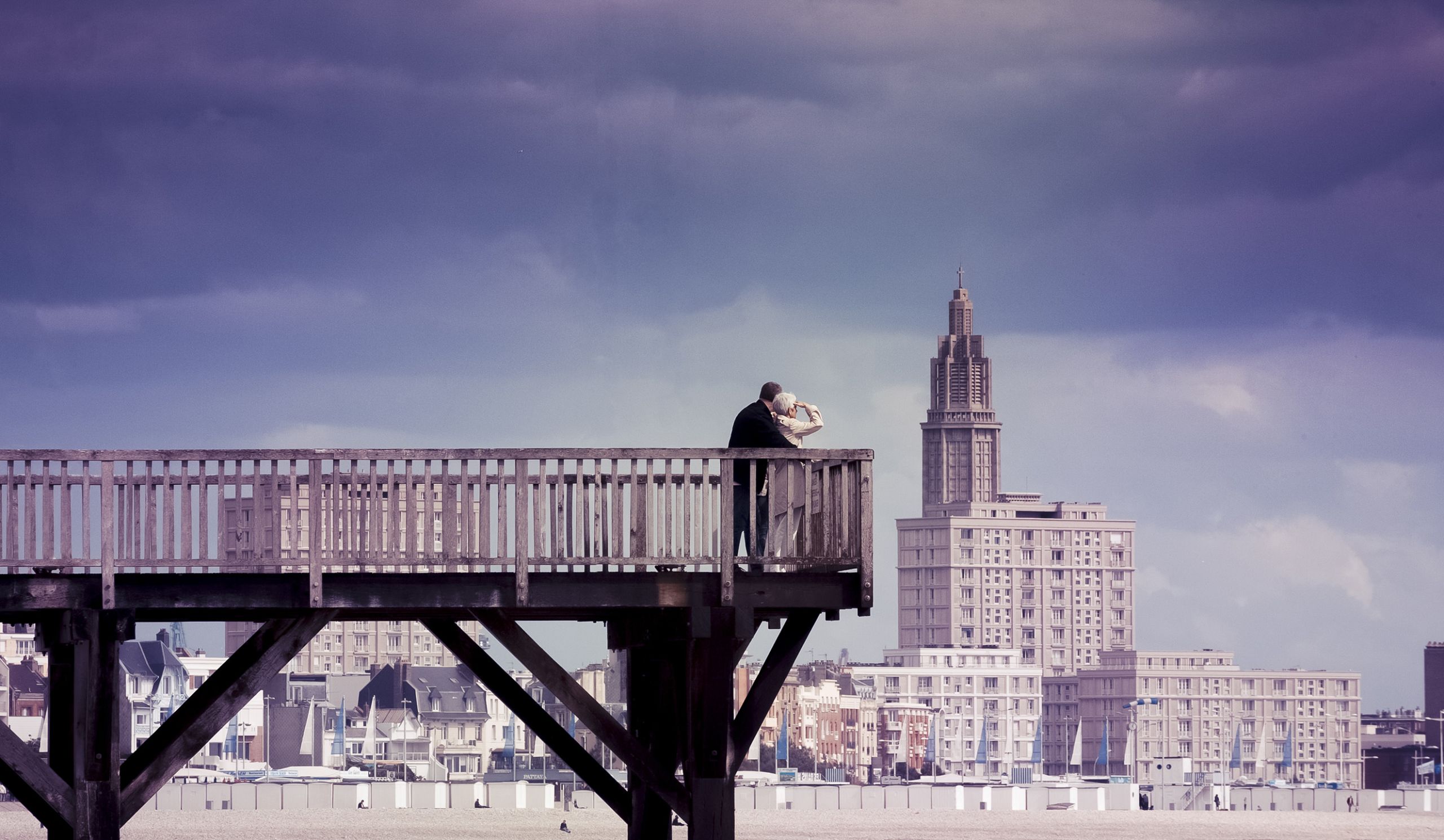
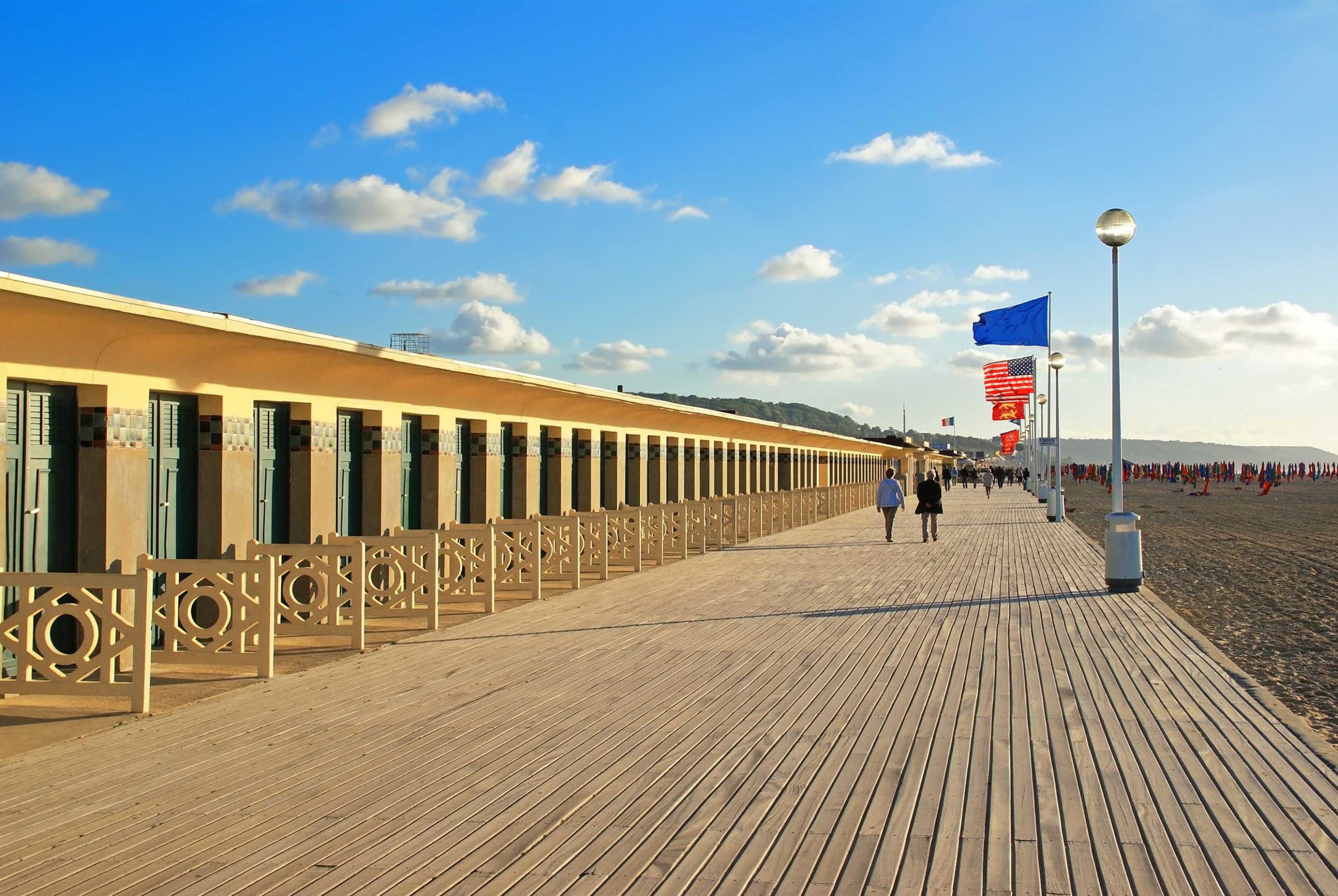
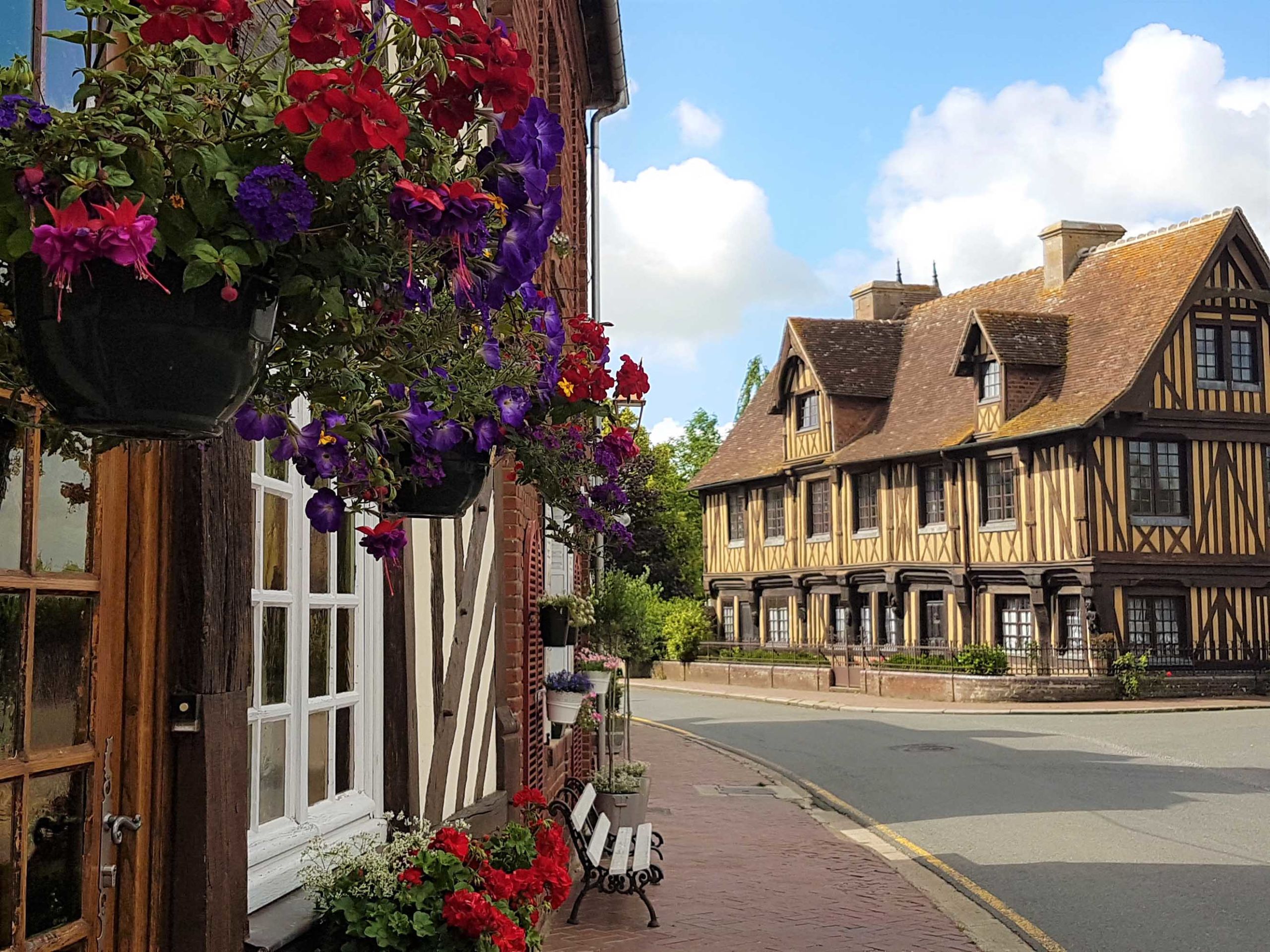
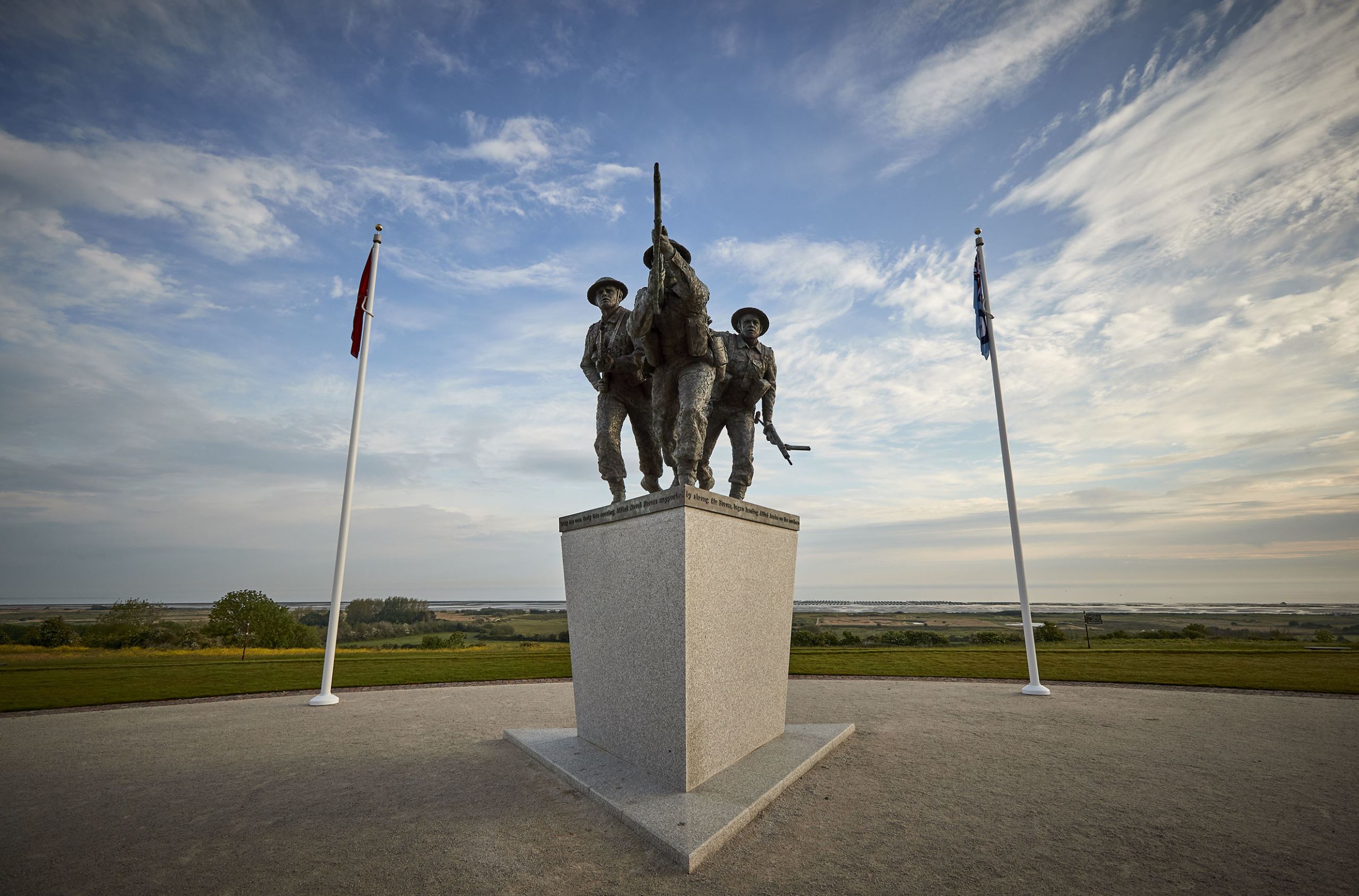
Road trip three: Discovering local life
A revealing road-trip through authentic France’s food, wine and ‘L’Art de Vivre’…

1. Cherbourg to Pont-l’Évêque
Distance: 171km (by car)
Sail into Cherbourg with Brittany Ferries’ service from Poole or Portsmouth and start your trip around half-an-hour east at the village of Saint-Vaast-la-Hougue. The alluring fishing village was voted France’s favourite in 2019 (in the Village Préféré des Français TV show). Saint-Vaast-la-Hougue is famed for the oyster beds that lie between the mainland and Tatihou Island, which can be reached on foot at low tide or by a special amphibious vehicle when the water is high. Each August, the island hosts a folk music festival called Les Traversées de Tatihou. Tuck into the oysters at local eateries such as the beachside Le Goeland 1951 café on the other side of the bay at Pointe de Saire. From there, head 180km into the Pays d’Auge for another of Normandy’s gourmet offerings: calvados (a type of brandy made from apples).
2. Pont-l’Évêque to Fécamp
Distance: 75km (by car)
As well as being known for its eponymous cheese, the town of Pont-l’Évêque is home to the Calvados Experience at the Père Magloire distillery. This immersive visitor centre is a treat for all five senses and not only allows you to learn about the production of the region’s celebrated apple brandy, complete with a tasting session, it also tells the story of the Normans, from their Viking origins to the present day. Meanwhile at Fécamp, on the Alabaster Coast, the neo-Gothic Palais Benedictine is where you’ll learn about the Benedictine liqueur that the eponymous palace was built to distil. Learn the story of the invention of the liqueur, enjoy a tasting bar and join in with cocktail making classes.
3. Fécamp to Dieppe
Distance: 64km (by car)
The seaside town of Fécamp is framed by its 90m white cliffs. Before leaving, stroll down to its yacht-filled harbour to learn more about its centuries-old fishing heritage. From there, it’s on to Dieppe, an hour up the coast for more food-focussed treats. Its market was named the finest in France in 2020 and it abounds with local produce from cider to cheese including Normandy’s four most famous fromages: Camembert, Livarot, Pont-l’Évêque and Neufchâtel. Even on the days when the market isn’t in action, the town’s food shops are a joy to explore for treats to take home. Pause for a coffee at Café des Tribunaux, set in an 18th-century Norman building and a stopping point for many of Dieppe’s famous visitors.
4. Dieppe to Craon
Distance: 372km (by car)
Follow the road south towards the Atlantic Loire, pausing for a pitstop in Rouen, which offers its own bounty of good food. Just outside the city, the bakery Aux Délices Normands beat off competition from 130 others to win the TV show La Meilleure Boulangerie de France. Also in Rouen is France’s oldest inn which dates from even before Joan of Arc met her fate in the square outside. La Couronne opened in 1345 and is now a sophisticated restaurant serving an enticing menu of classic French and local regional specialties under its ancient beams. From Rouen, travel some 200km south-west to discover the peaceful Mayenne countryside.
5. Craon to Nantes
Distance: 101km (by car)
Start at La Ferme du Pressoir near Craon, a cider and fruit farm that has belonged to the same family for five generations. Among their specialities is ice cider made with natural cold, liqueurs and eaux-de-vies (a type of brandy that literally translates to ‘water of life’.) At the farm you can visit the cellars and learn more about their production. Continue on past Angers, where even the chateau has a vineyard on top of its ramparts, to Brissac-Quincé, a town dominated by its elegant chateau and home to the vineyard La Belle Etoile, which has also been in the same family for five generations. Tour the vineyards, see the cellars and taste the wines to learn more about the Anjou wine-growing region. From there, drive for an hour-and-a-half to Nantes, where you can stroll the old town to duck in and out of the speciality food shops.
6. Nantes to Clisson
Distance: 33km (by car)
This almost 120km wine route from Nantes to Clisson runs between some excellent vineyards, giving you the chance to taste the region’s flagship wine Muscadet, as well as wines made with lesser-known grape varieties Melon de Bourgogne and Folle Blanche. From Nantes, drive through the landscape around the Sèvre Nantaise river. Stop for a picnic along the bank at Chaussée des Moines in Vertou, or at the port of La Haye-Fouassière. Then it’s on to Clisson, a town with a distinctly Italian vibe thanks to its Renaissance villas that are reminiscent of Tuscany.
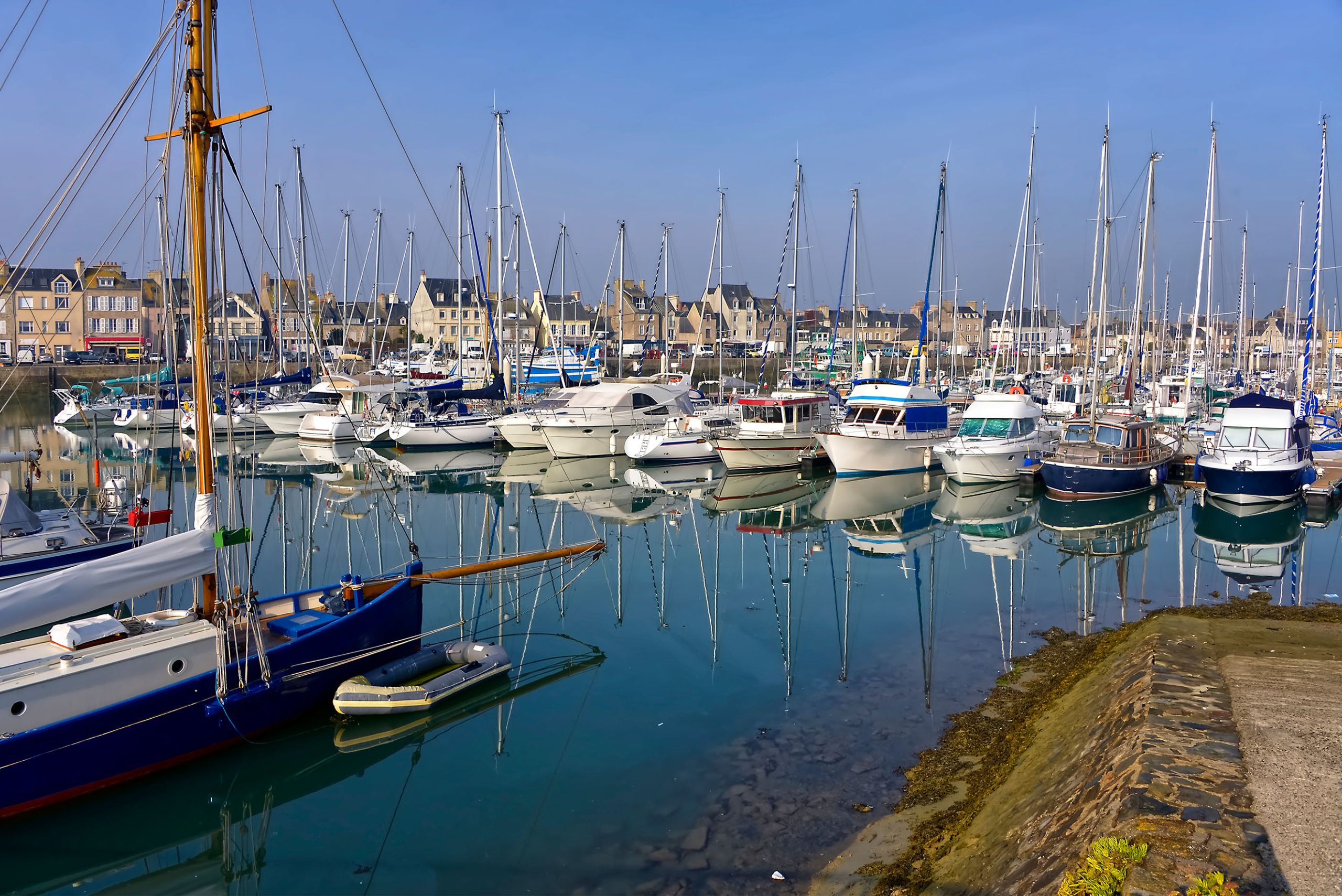
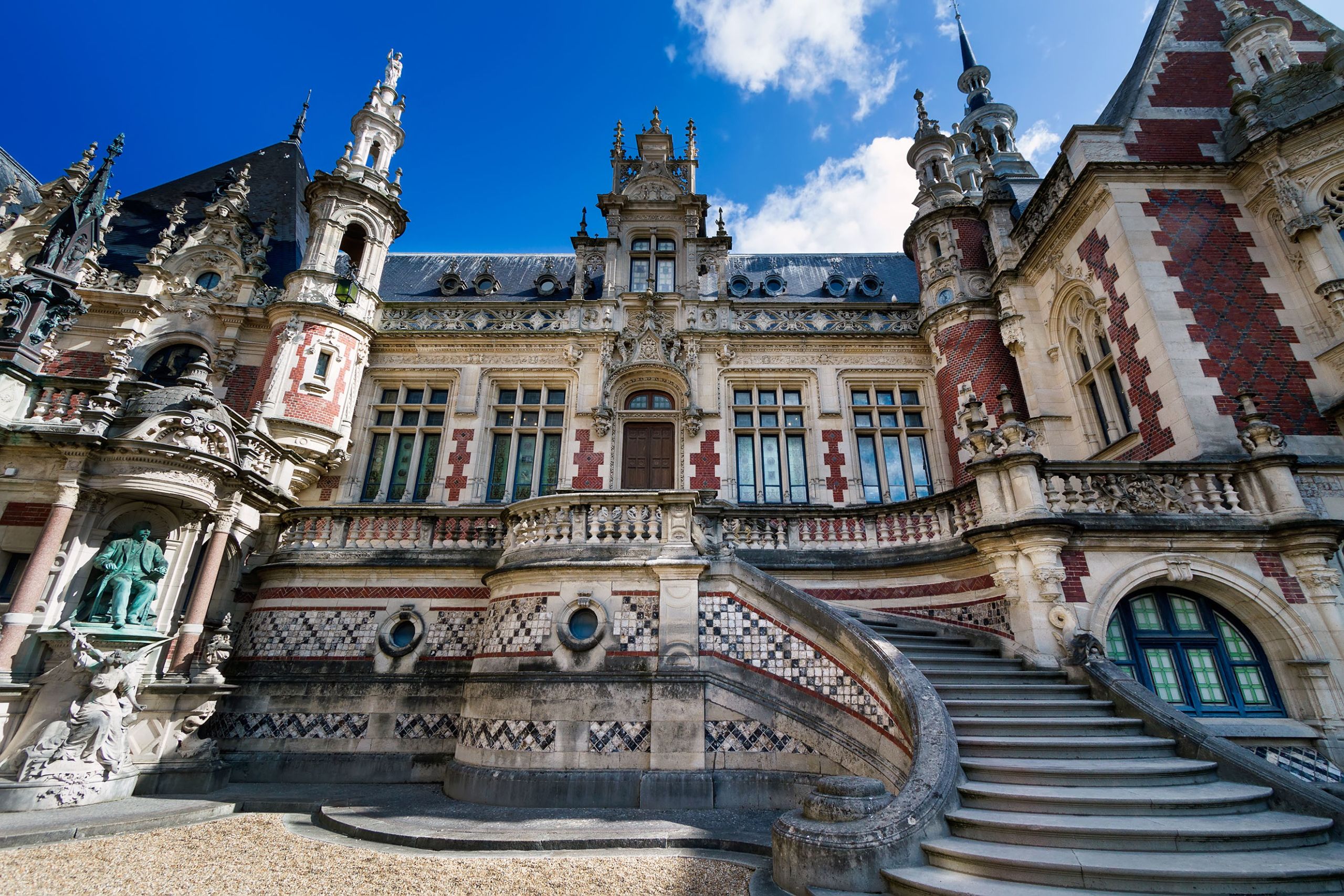
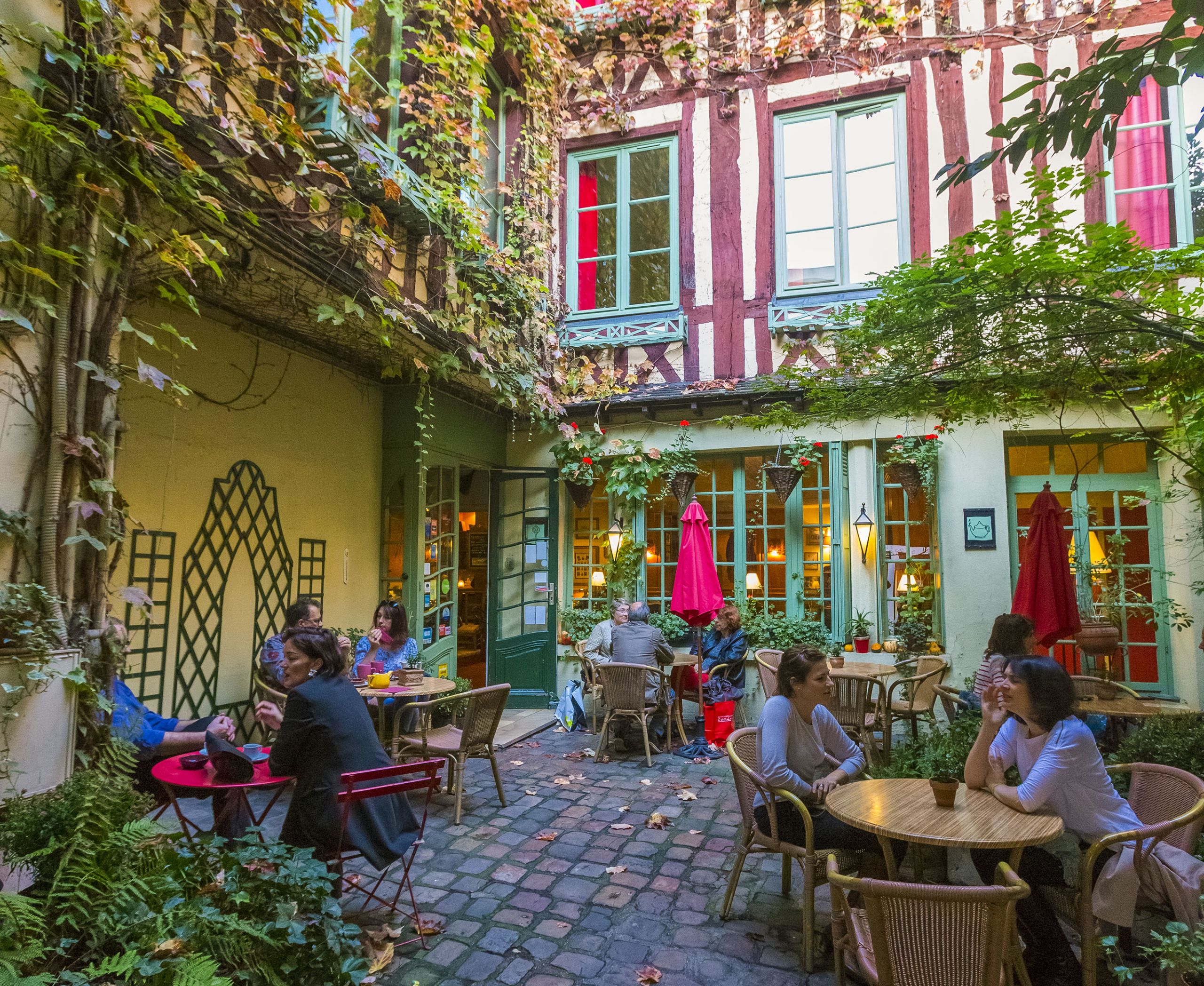
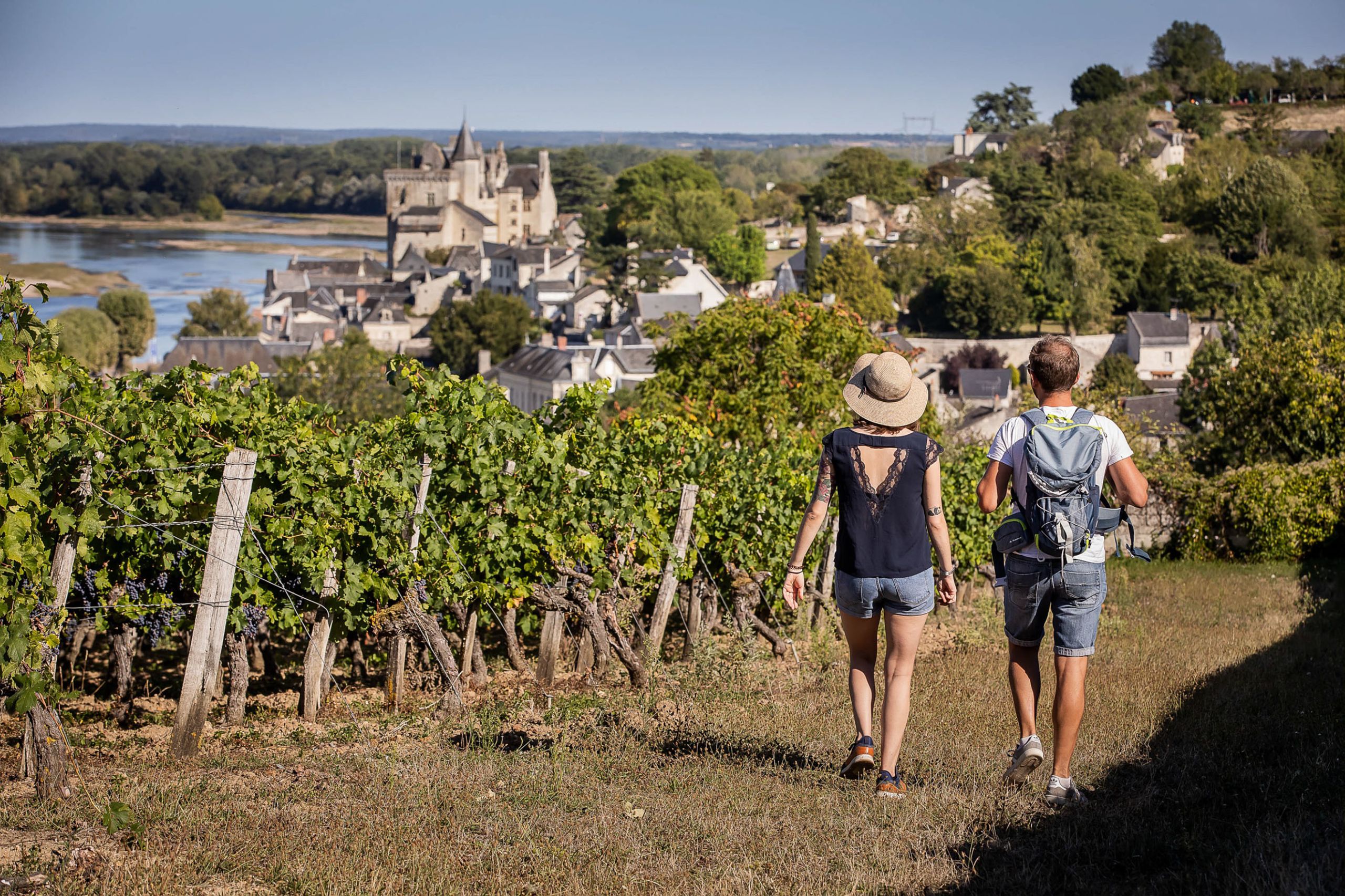
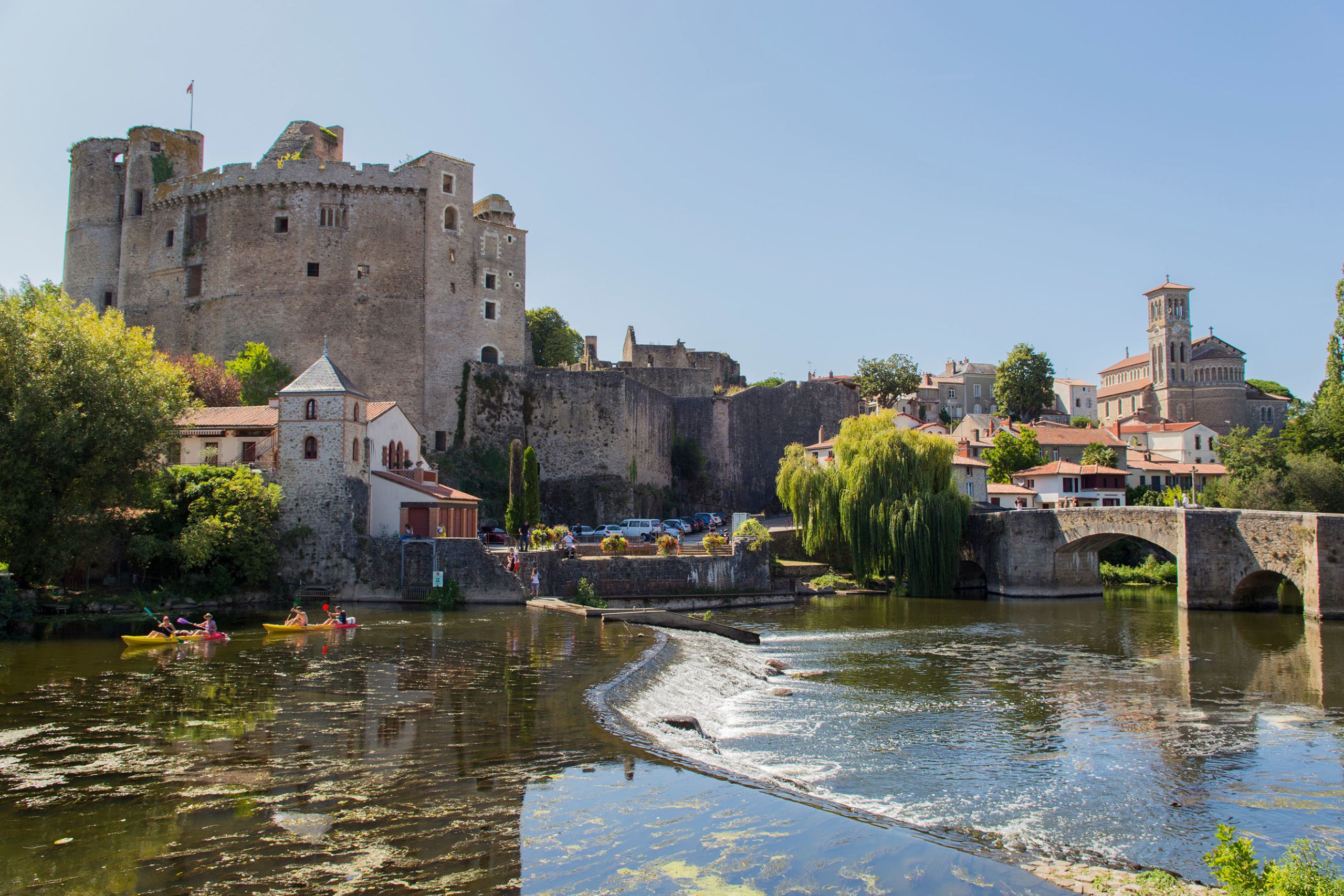
7. Clisson to Noirmoutier
Distance: 100km (by car)
Around an hour-and-a-half’s drive west will land you on the island of Noirmoutier, just off the Vendée coast. The island is known for its seafood and gourmet potatoes – les bonnottes de Noirmoutier – which thrive in the mild climate, the salty air and the sandy earth, enriched by seaweed. Like Guérande on the border with Brittany and Olonne to the south on the Vendée coast, Noirmoutier is known for its salt production. Its salterns (salt pans) date as far back as the 5th century and some 100 salt-makers that still produce the mineral using traditional methods.
Shellfish lovers should join in with pêche à pied (digging for shellfish) on the beaches at low tide. The various beaches each offer different types. Look for cockles, winkles and clams close to ‘Le Gois’, the causeway that links Noirmoutier to the mainland, or find pink shrimps, winkles, clams, crabs and cupped oysters at the other end of the island at Le Vieil and L’Herbaudière beaches.
8. Noirmoutier to Vannes
Distance: 176km (by car)
Stop off at Guérande on the way north to see its salt marshes where you can visit the Terre de Sel visitor centre and take a horse-drawn cart ride around the salt pans. Next, head towards the inland sea, the Gulf of Morbihan. Take a detour around the Rhuys peninsula, stopping at the Ferme Fromagère de Suscinio to taste its Tome de Rhuys cheese, made with Guérande salt, at the farm’s Le Pie Noire Café. Next, head half-an-hour north to the secluded village of Séné for a plate of fresh oysters at the beachside La Belle d’Ilur. Drive 20 minutes south to the town of Vannes for a meal at Empreinte, a restaurant that sources the ingredients (organic meat, raw milk and cheese and fresh fish, to name a few) for its menus from the bounteous region around it. In Sulniac, around 20 minutes away, the family-run Distillerie du Gorvello is the place to snap up their ciders, eaux-de-vies and cider vinegars.
9. Vannes to Douarnenez
Distance: 145km (by car)
There’s more cider to be found further west in the region known as Cornouaille (France’s own Cornwall), to the south-west of Finistère, where a cider route links different farms and distilleries. Visit the orchards, meet the producers and try the products, including the lesser known Pommeau de Bretagne, and eau de vie de cidre. Douarnenez, meanwhile, is famous for its sardine fishing industry and for being the birthplace of the Kouign-Amann, translating to ‘cake of butter’. The sweet treat has fans the world over and many boulangers adapt their recipes with apples, or the local speciality, blé noir (buckwheat). This nutty flour also forms the base of Brittany’s galettes, savoury pancakes served with everything from cheese and ham to seafood.
10. Douarnenez to Roscoff
Distance: 100km (by car)
On the north coast of Finistère, Roscoff is known for its pink onions, but a newer industry has been making waves there since the ’90s. Algoplus is a company that has been farming seaweed for over 20 years, transforming the plants into unusual food products (including green sea beans and sea parsley) as well as cosmetics. Pay a visit to their shop on the harbourside at Roscoff and taste them for yourself.
11. Roscoff to Rennes
Distance: 212km (by car)
Heading east into the heart of Brittany, make a penultimate stop at the region’s capital, Rennes. Here, the ‘Bistronomy movement’ – fine gastronomy served in a more casual setting – is in full swing. Book into restaurants such as Bercail, le Globe, Bistro Les Darons, Café du Port or Le Tire Bouchon for great food served at the bar or in sight of the buzzing open kitchens. Also take time to explore Renne’s market in the Places des Lices, where some 300 sellers and 10,000 buyers flood to the streets. Seek out a stall selling the local speciality, galette-saucisse, a kind of hot dog where a sausage is wrapped in a buckwheat crepe.
12. Rennes to Saint-Malo
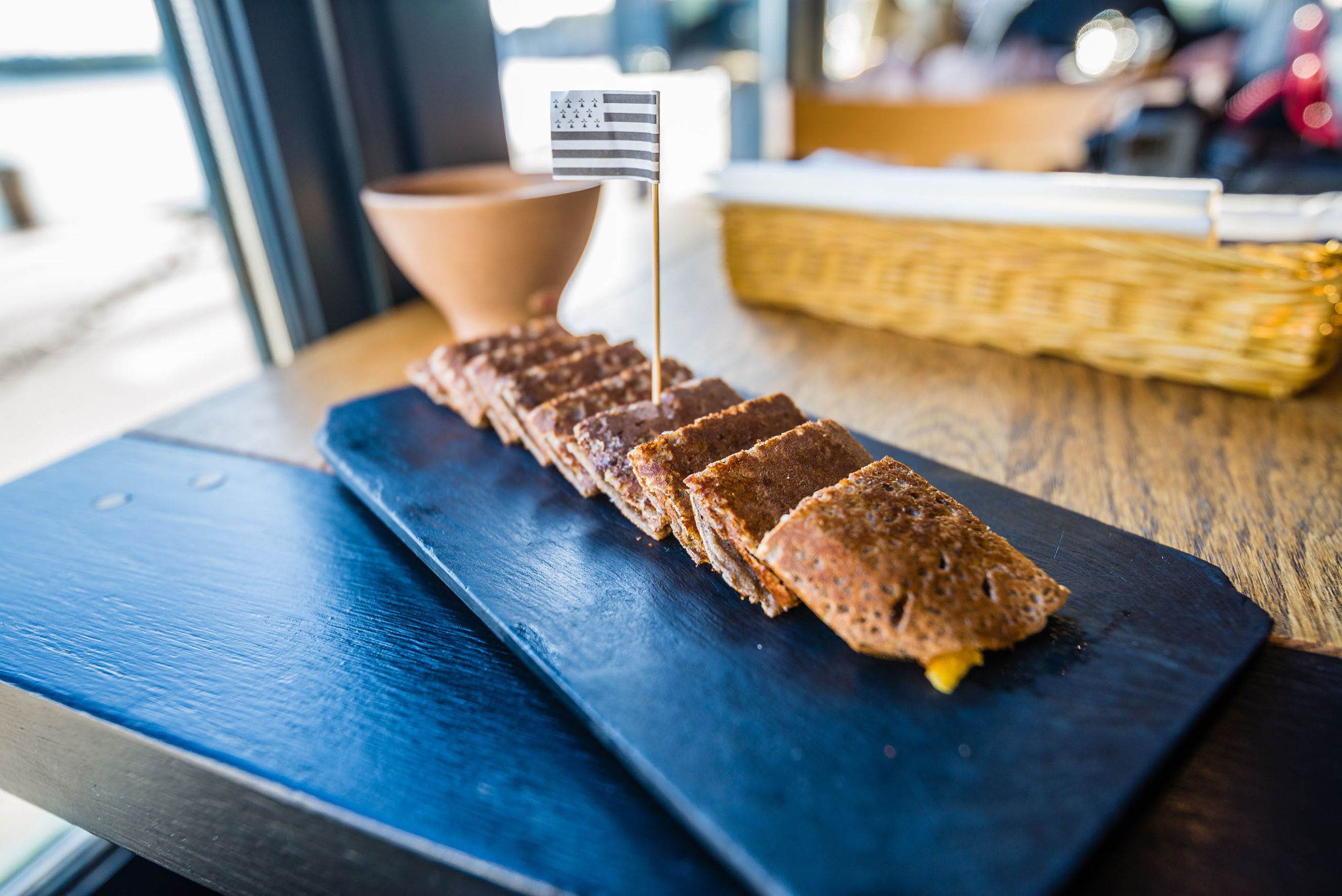
Enjoy crepes at Maison Breizh in St Malo
Enjoy crepes at Maison Breizh in St Malo
Distance: 88km (by car)
From Rennes, head 70km back to the coast to Cancale where you can learn how their famous oysters are grown on a trip around the oyster beds with the guides from Ostreika. Sample the delicacy either at the chic L’Atelier de L’Huitre or the more rustic beachside oyster market where you’ll be swigging back some of Brittany’s finest catch in full sight of Mont-Saint-Michel on the horizon. Before hopping on a Brittany Ferry back to Portsmouth, head into Saint-Malo to stock up on Breton specialities. Be sure to buy butter from La Maison du Beurre Bordier on Rue de l’Orme, including traditional salted and demi-sel (half-salted) butter as well as flavours such as seaweed and Madagascan vanilla. Across the road, La Maison du Sarrasin sells buckwheat in myriad forms, from biscuits to beer, meaning you’ll be heading back from Saint-Malo to Portsmouth on Brittany Ferries with a long-lasting flavour of Western France.
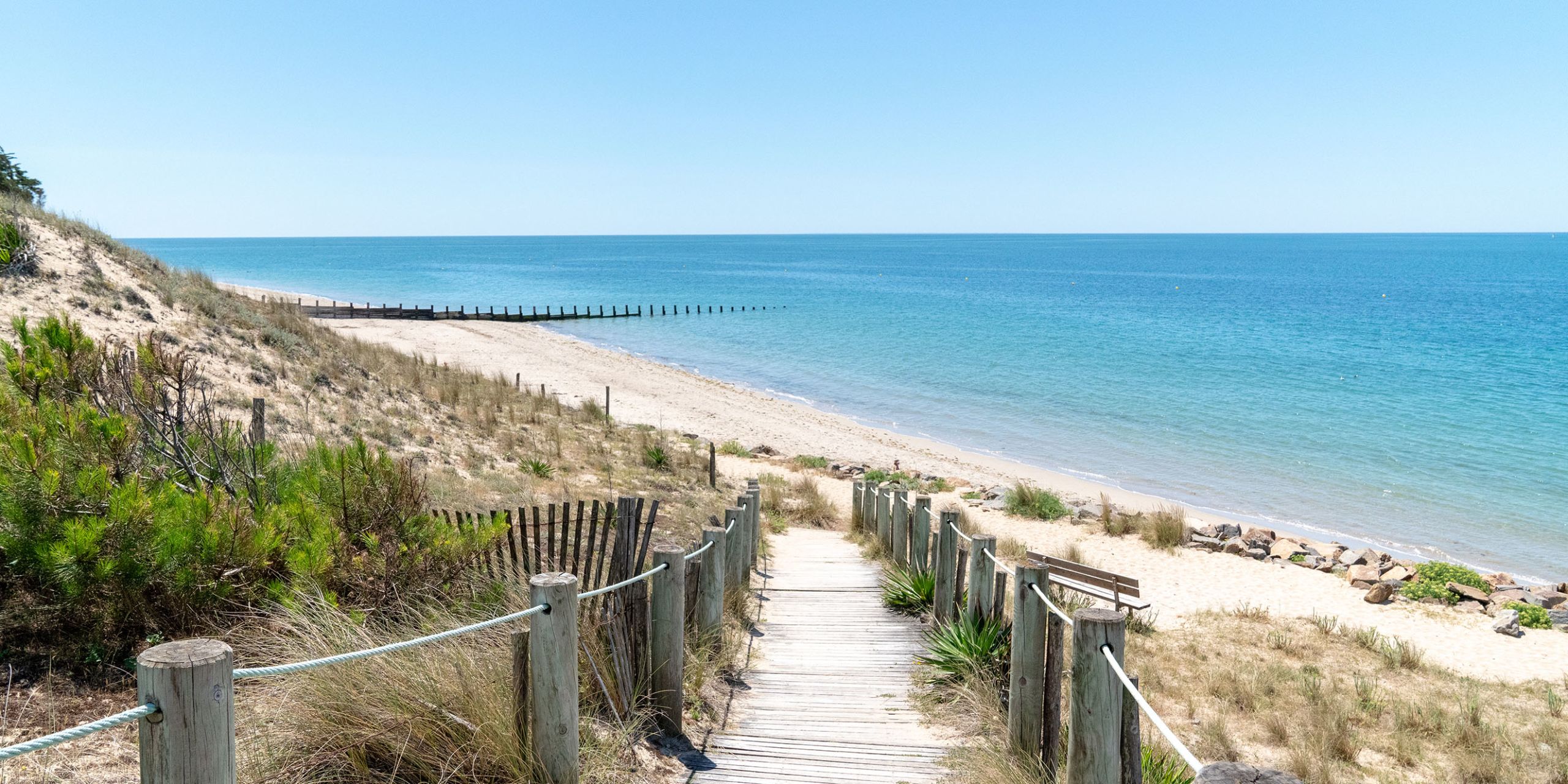
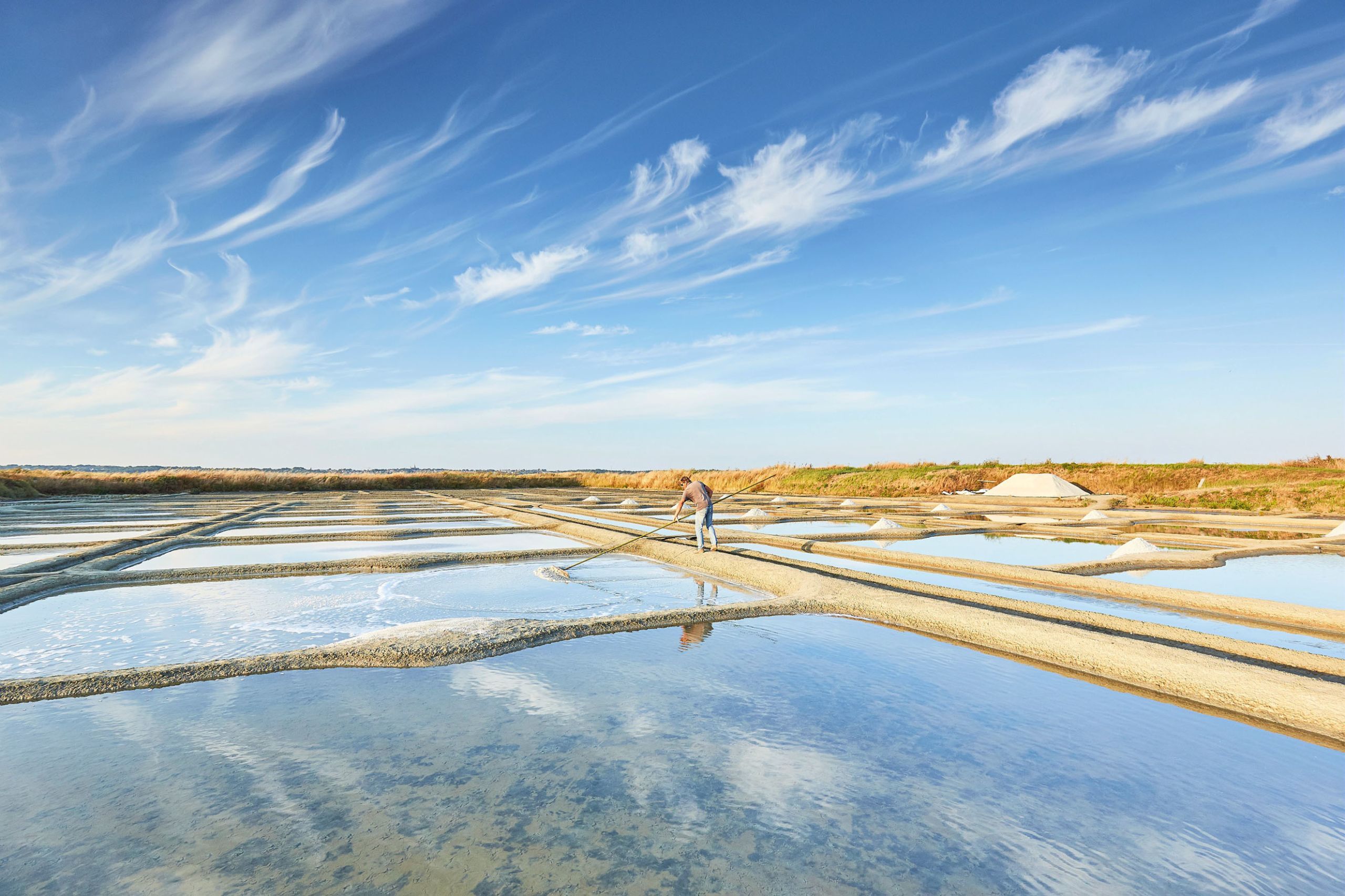
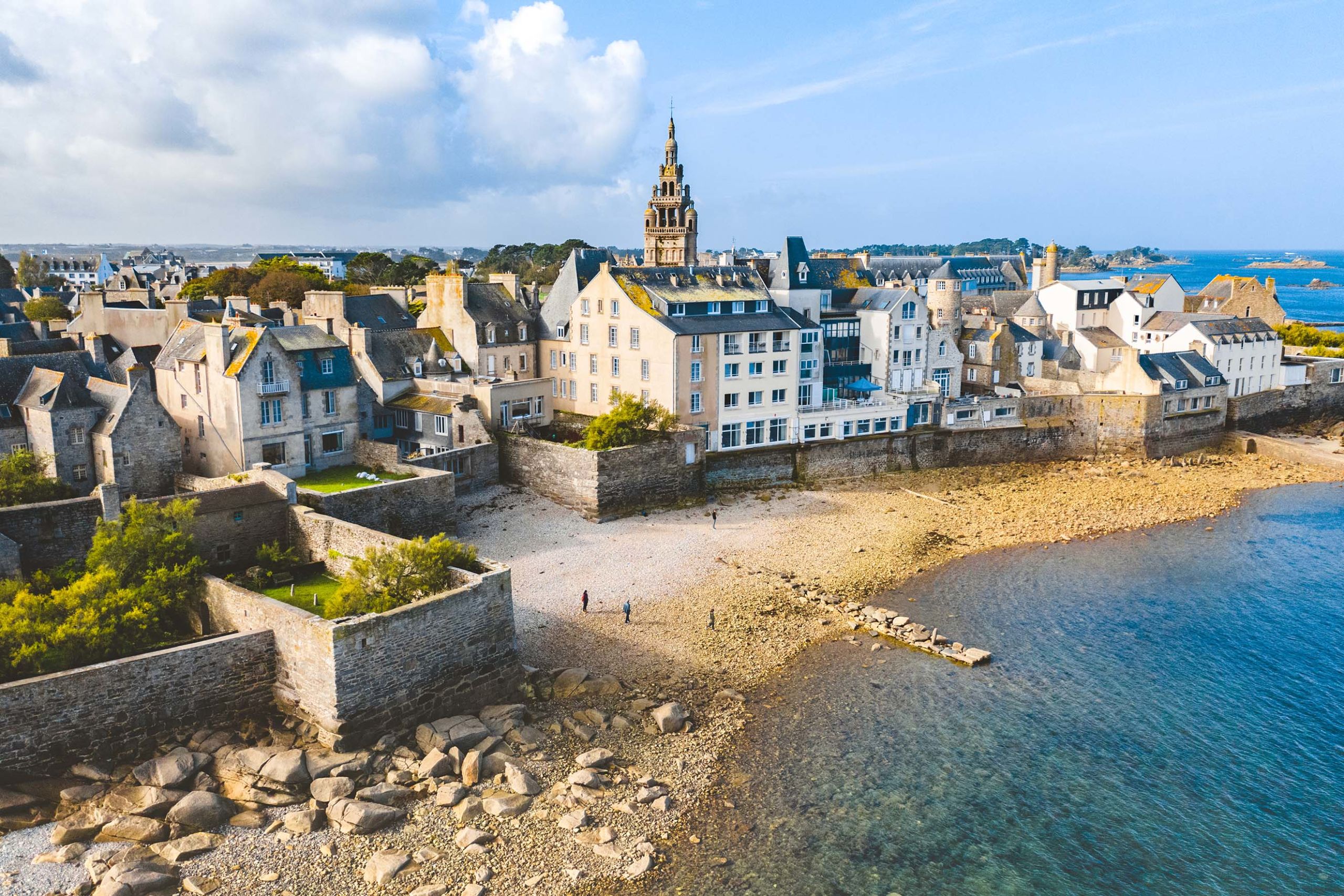
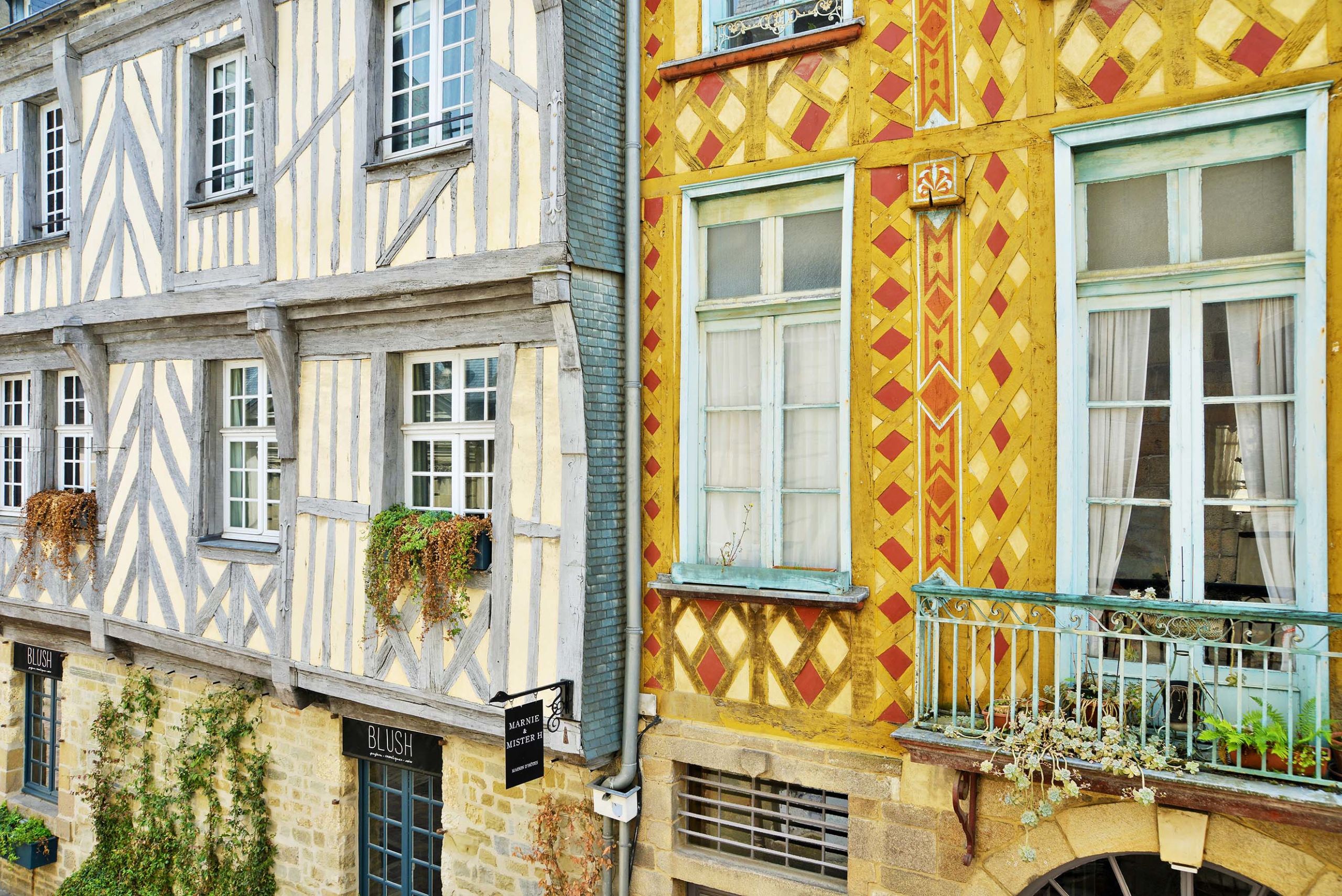
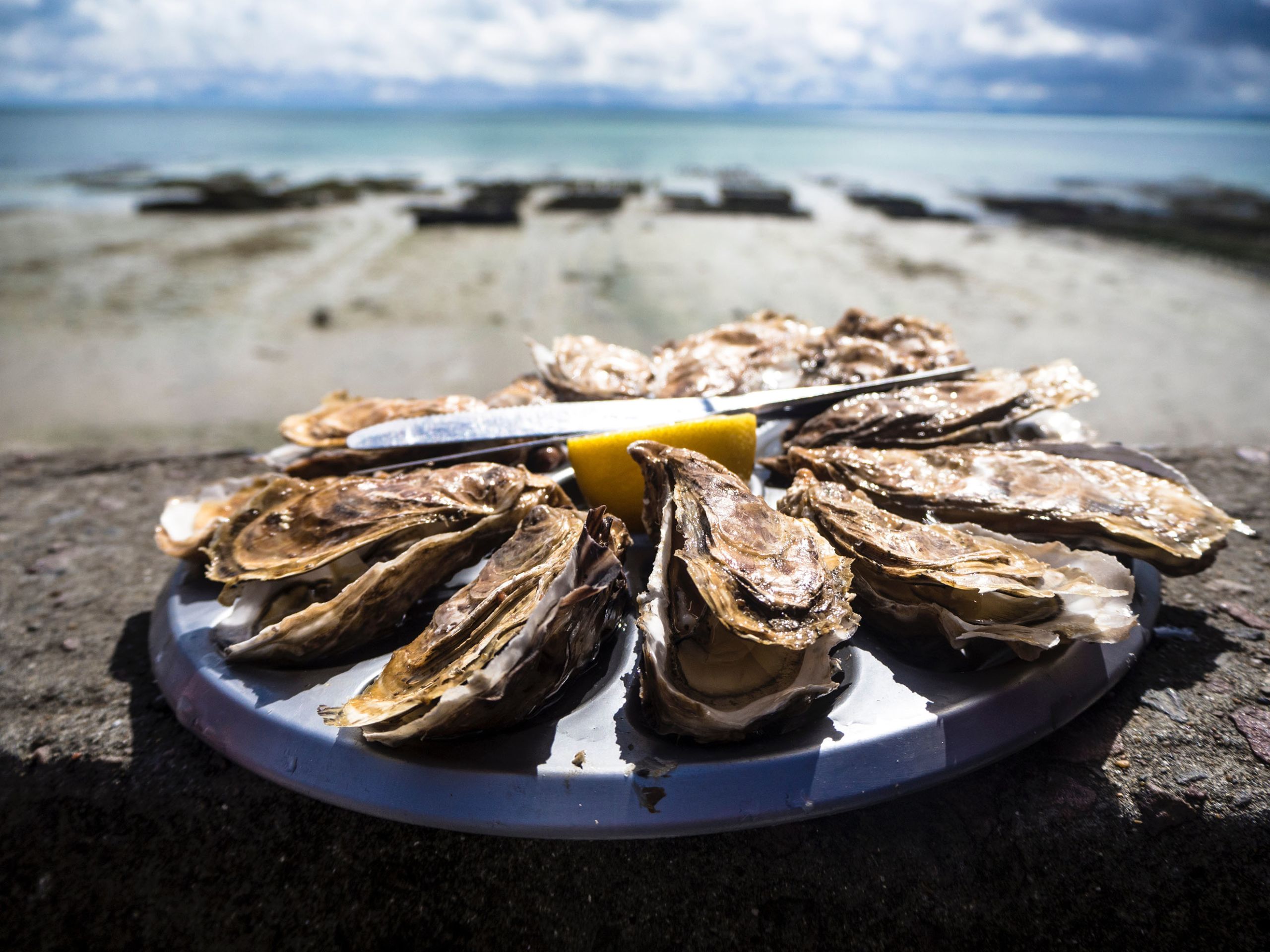
Reach Western France with Brittany Ferries

What better way to start a road-trip to Western France than by standing on deck watching land slowly shifting into view? Whether you choose to sail overnight in a comfortable cabin or choose a daytime sailing, Brittany Ferries will ensure your holiday gets off to a great start.
Sail into Caen (under six hours from Portsmouth) and within minutes of rolling off the ferry, you can be discovering the daring stories associated with D-Day at the Pegasus Bridge Museum and exploring the D-Day beaches.
From Cherbourg (just four-and-a-half hours from Poole, or an overnight trip from Portsmouth), the Cotentin peninsula awaits with its dramatic coastline and villages such as Saint-Vaast-la-Hougue.
Sail into Saint-Malo (an overnight ferry from Portsmouth) to indulge in its food scene, its corsair (pirate) history and the Emerald Coast.
Some 200km west, Roscoff (reachable by a six-to-eight-hour ferry from Plymouth or 14 hours from cork) delights with its fishing boats coming into the harbour, its cobbled streets and its proximity to Île de Batz, just a 15-minute boat ride away.
Not only is going by ferry more environmentally friendly, it’s a much more relaxing way to travel. Being in your own car means you can just fill the boot with all you need (and, for the return trip, all your favourite French food and wine) and explore where you want, when you want, at your own pace.
To see all of the routes Brittany Ferries has on offer and to start planning your trip to Western France, head over to the official Brittany Ferries website.
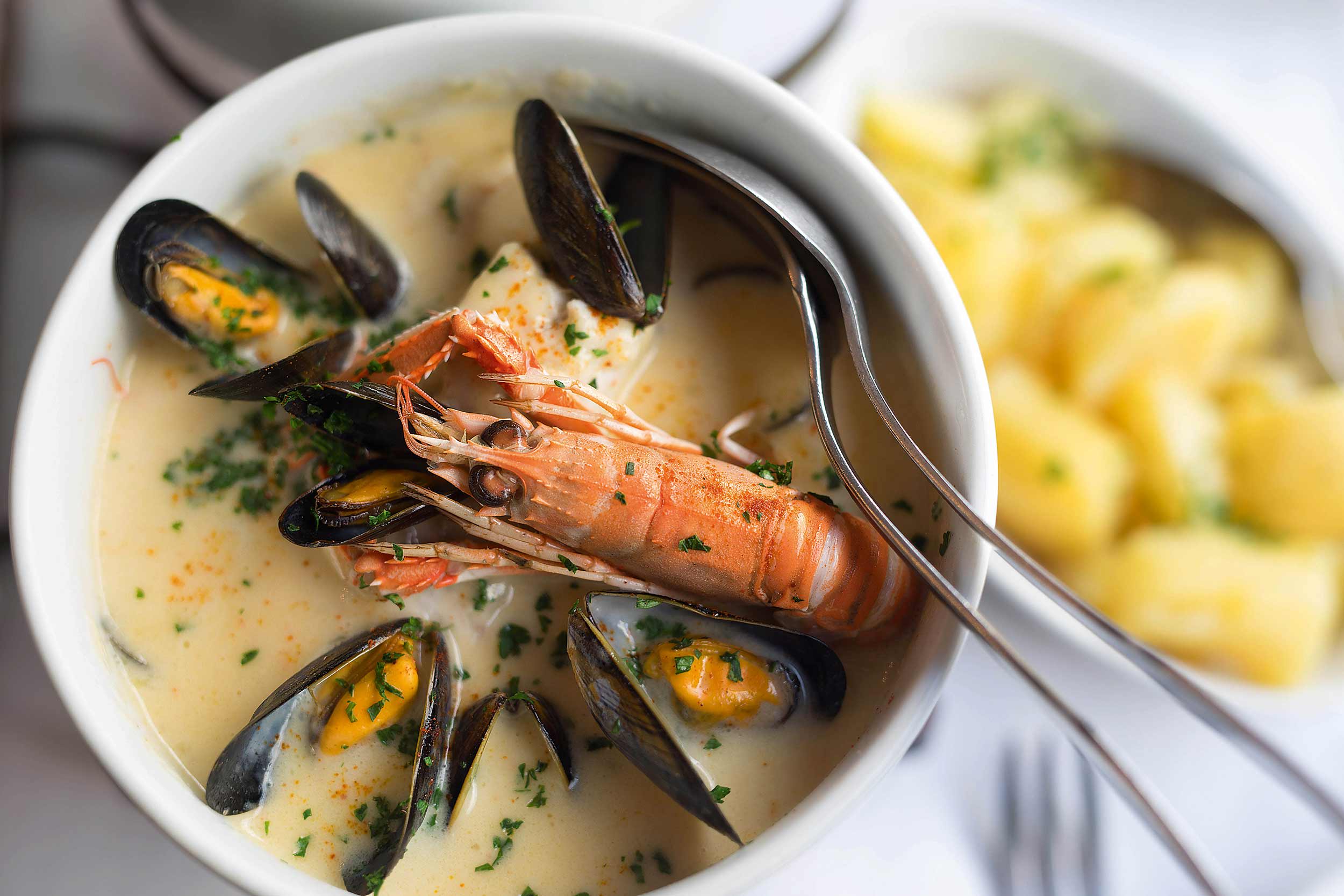

Image credits top to bottom: Shutterstock; Sabina Lorkin; Shutterstock; JFL Photography; Emmanuel Berthier; Nicolas Job; Loic Kersuzan; Shutterstock; Atlantic Loire Valley Tourisme; D Drouet; P Beltrami; Shutterstock; Thibault Poriel; Eugenie Ragot; Alexandre Lamoureux; Atlantic Loire Valley Tourisme; Shutterstock; Melanie Chaigneau; Maxime Odoux; Marie Anais Thierry; Vincent Rustuel; Shutterstock; B. Collier; Kiran Ridley; Shutterstock; Vincent Rustuel; Atlantic Loire Valley Tourisme; Shutterstock; Alexandre Lamoureux; Thibault Poriel; Franck Hamon; Thomas Cantelli Video credits: © Bokeh Prod; © Thib’s Prod; © 441 pictures



